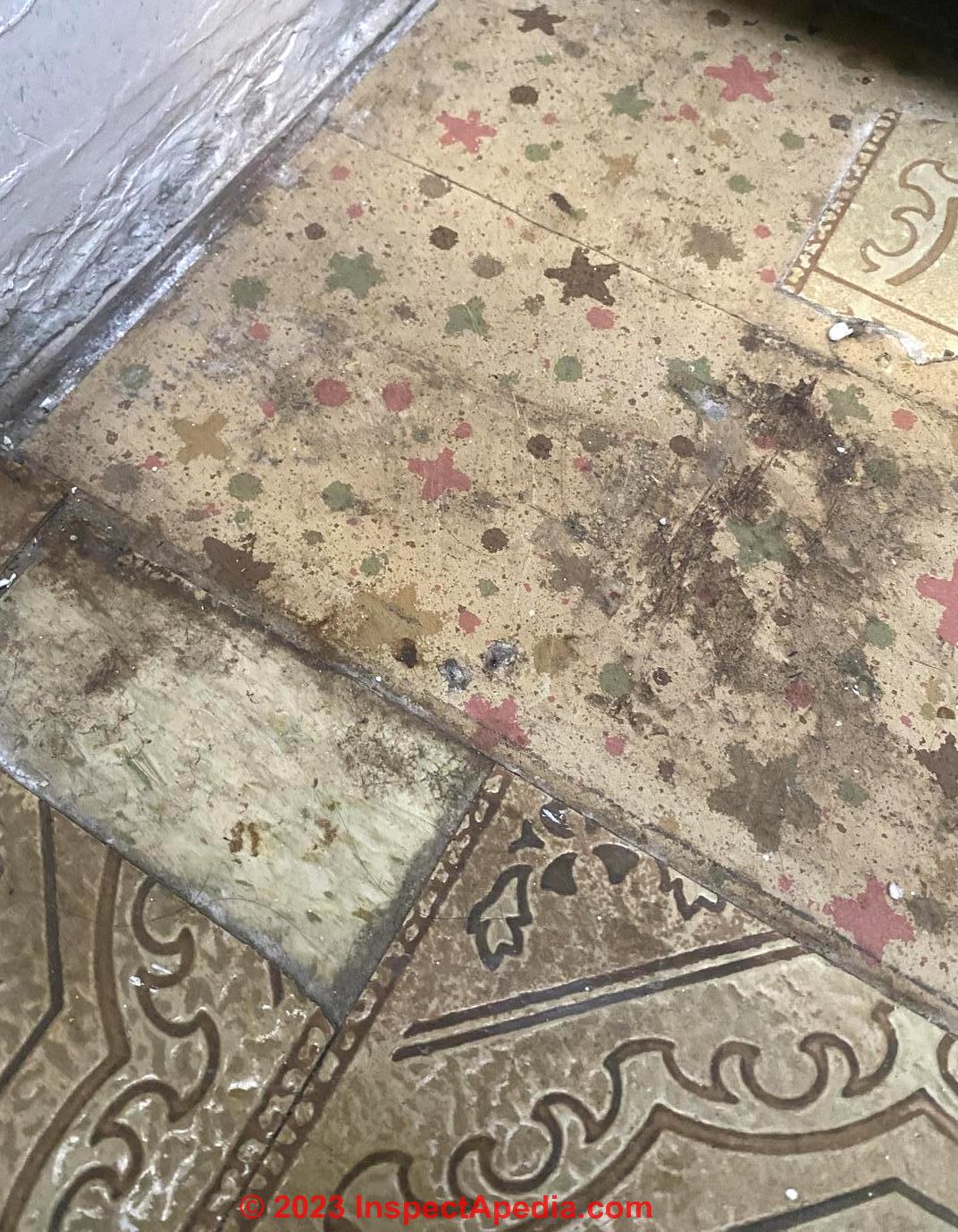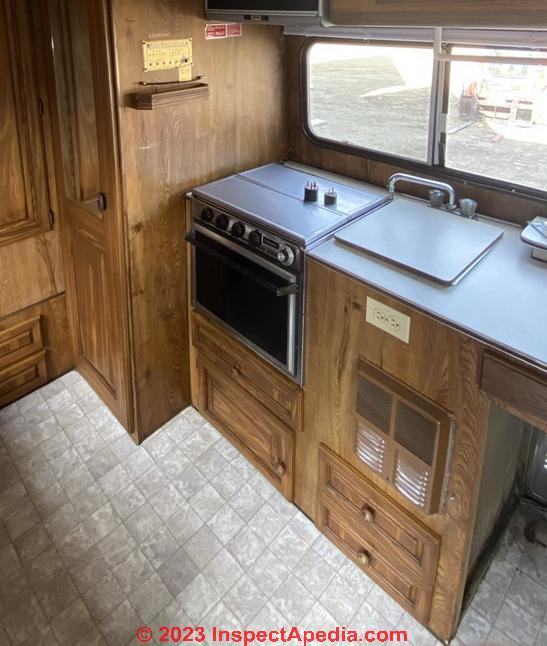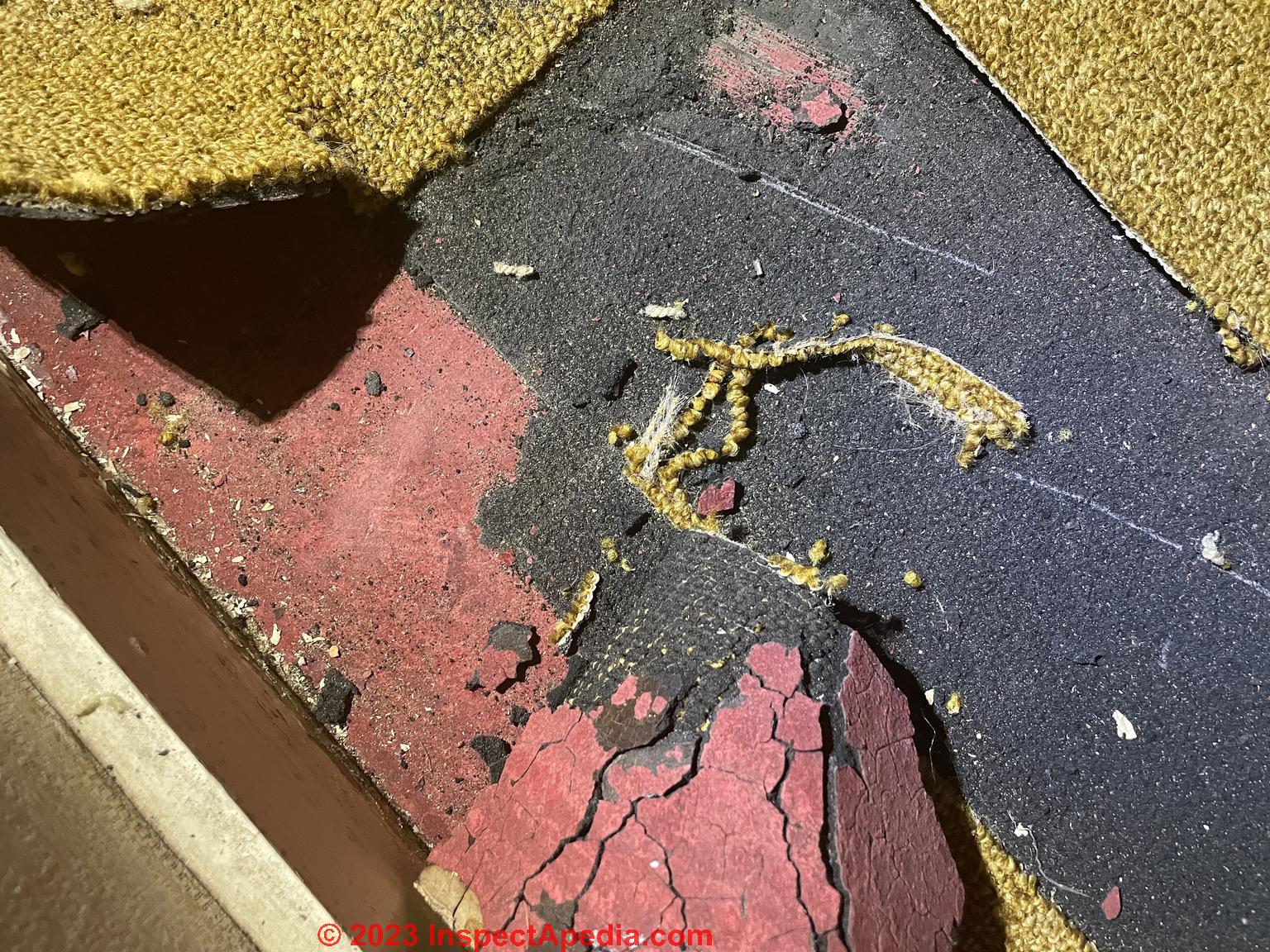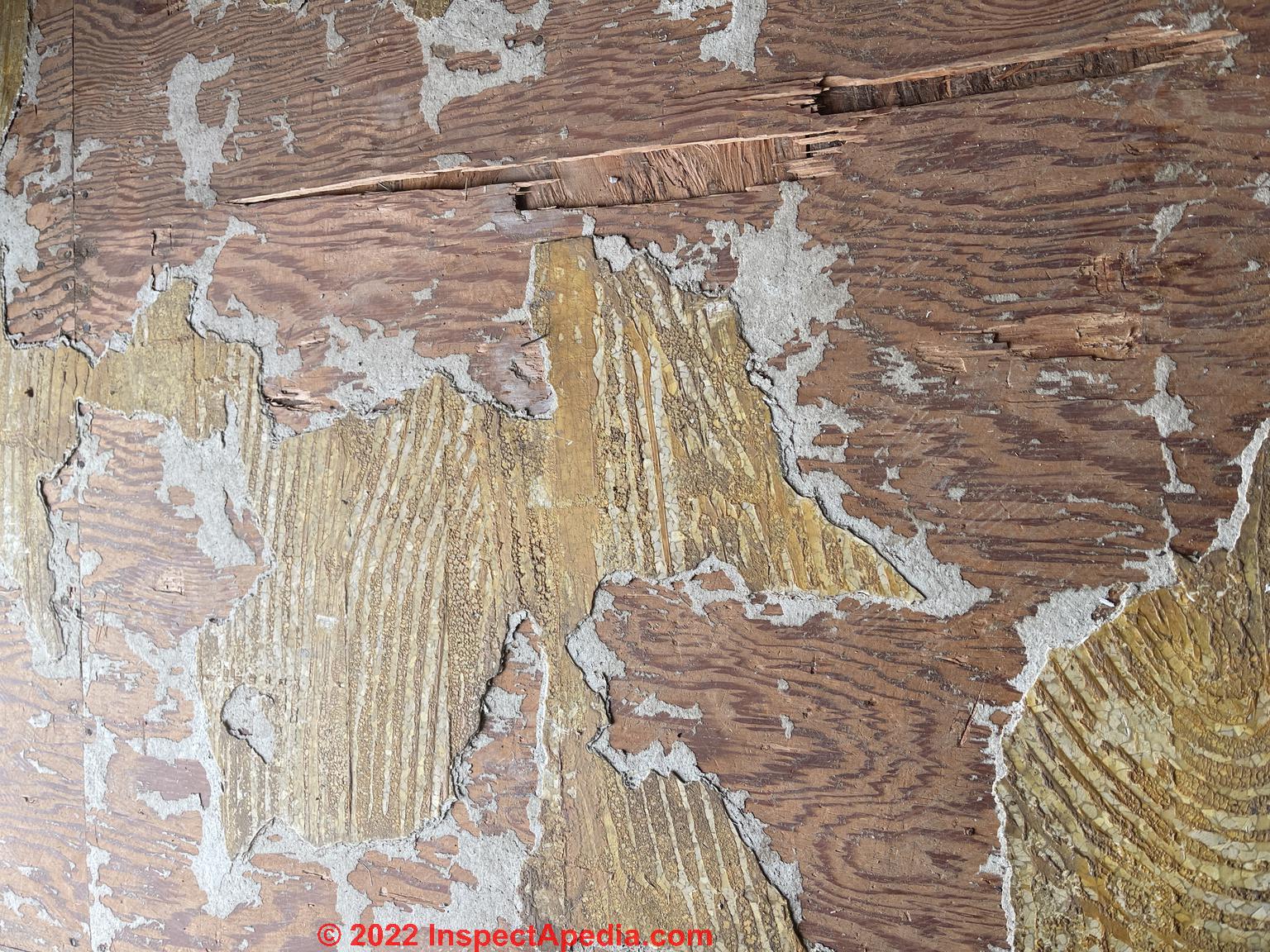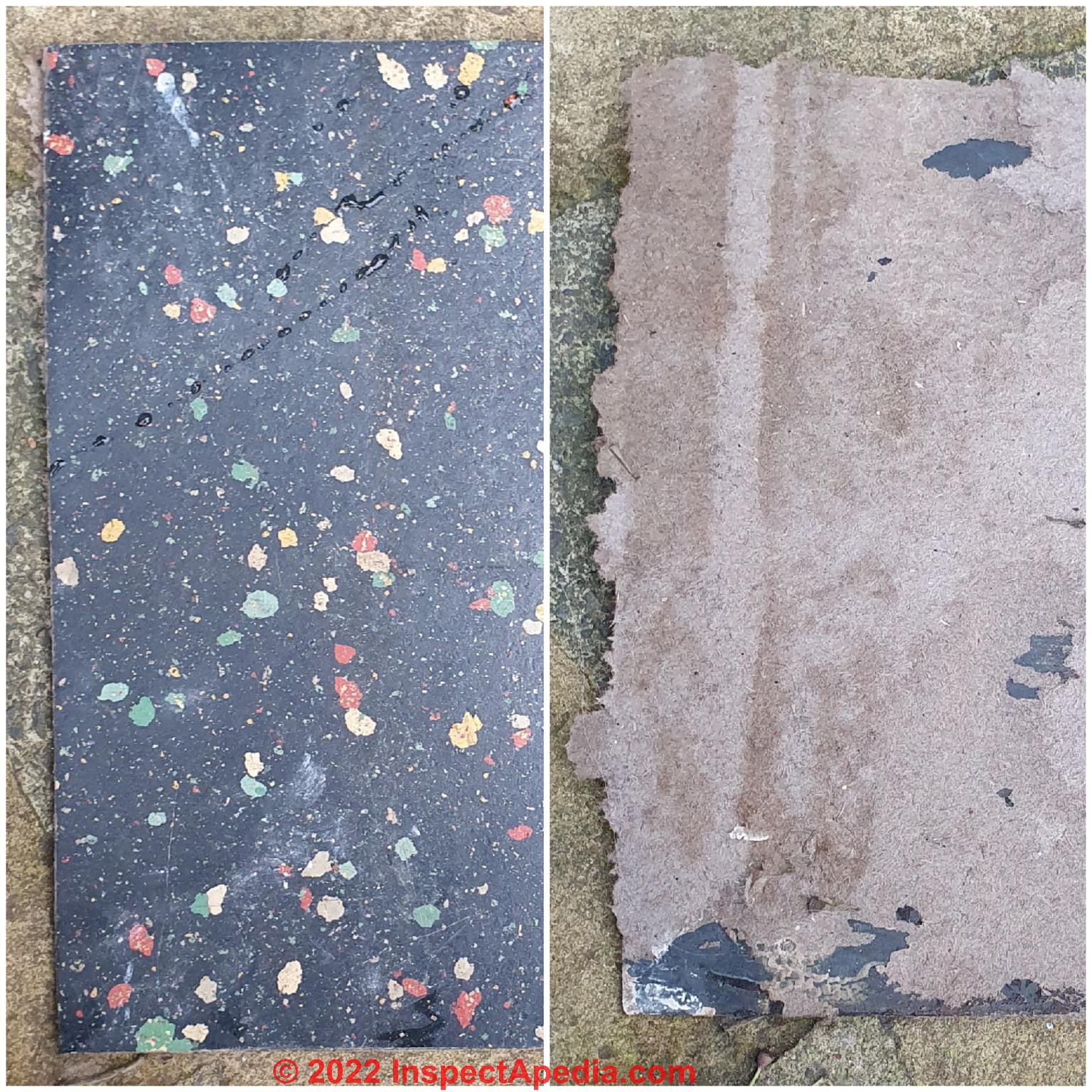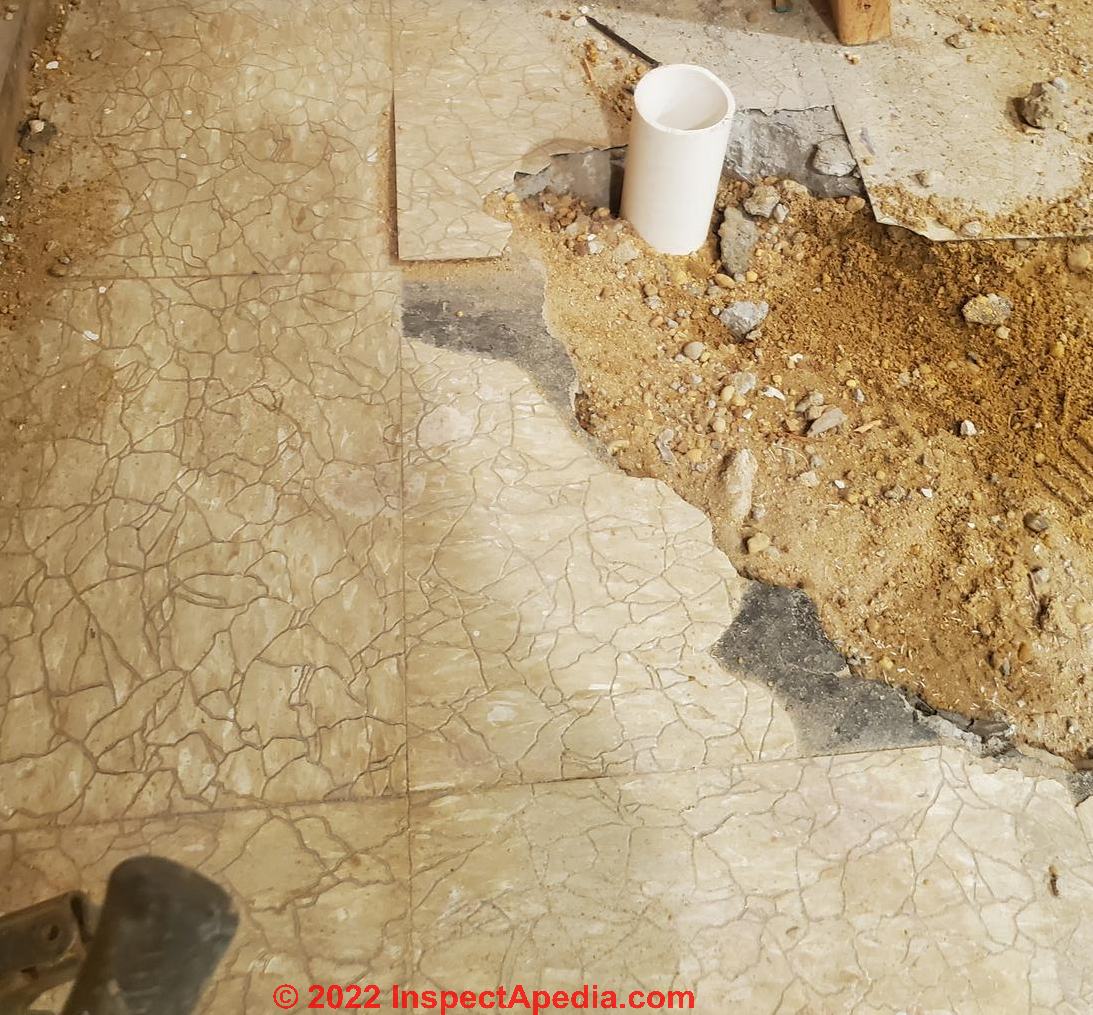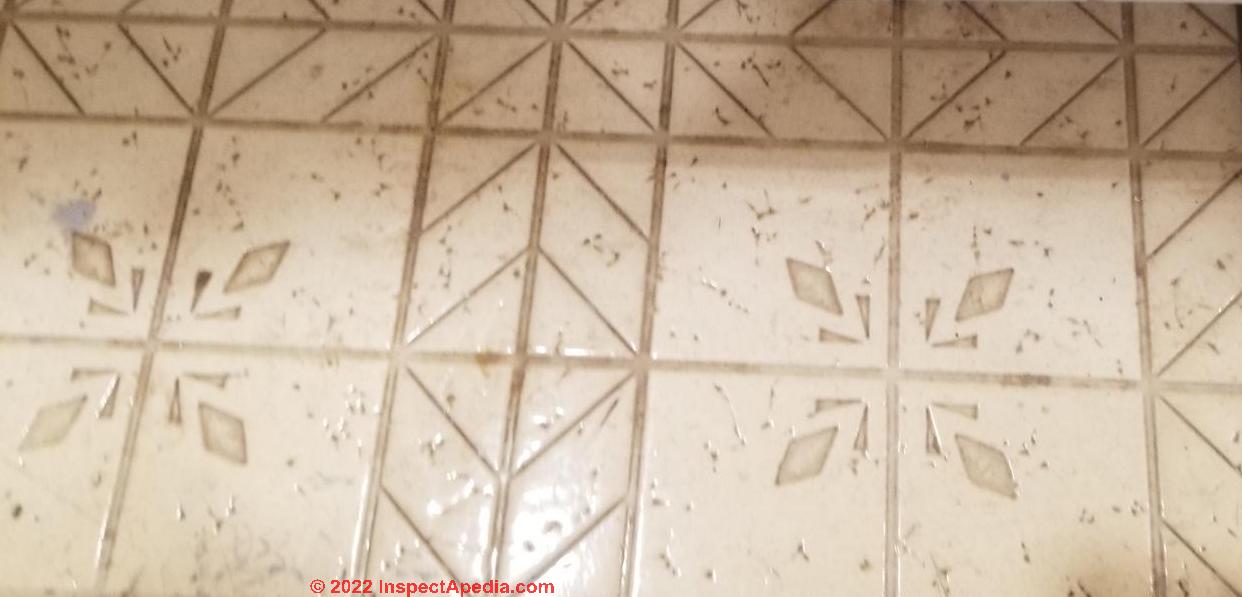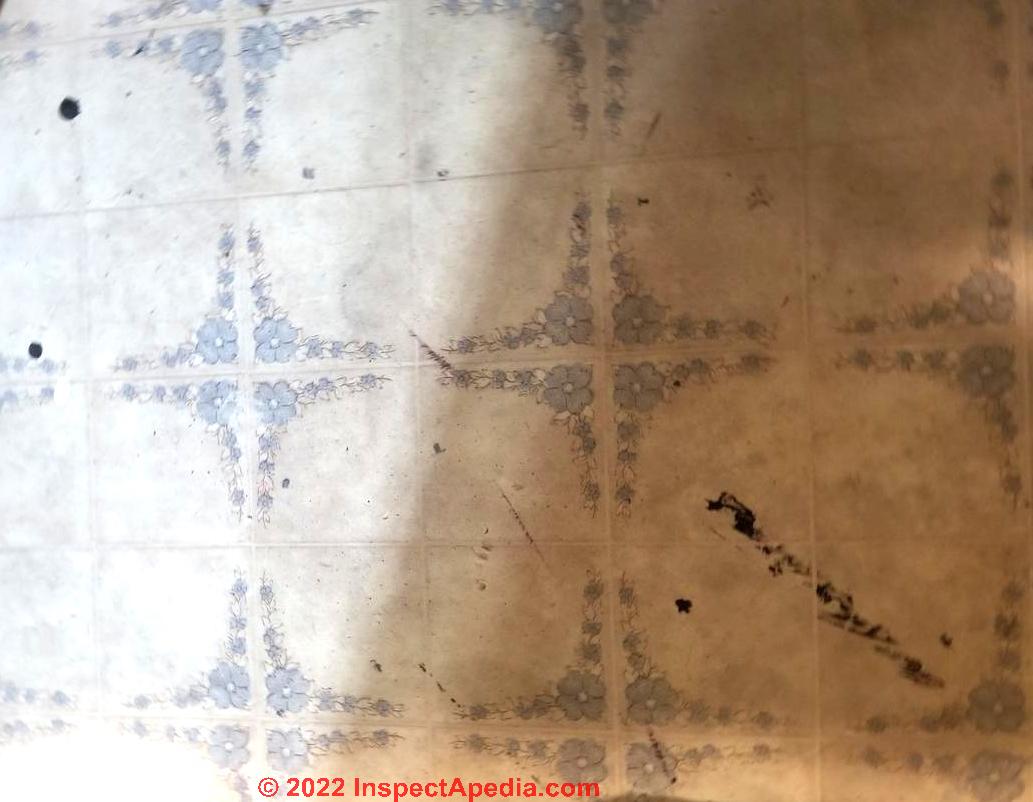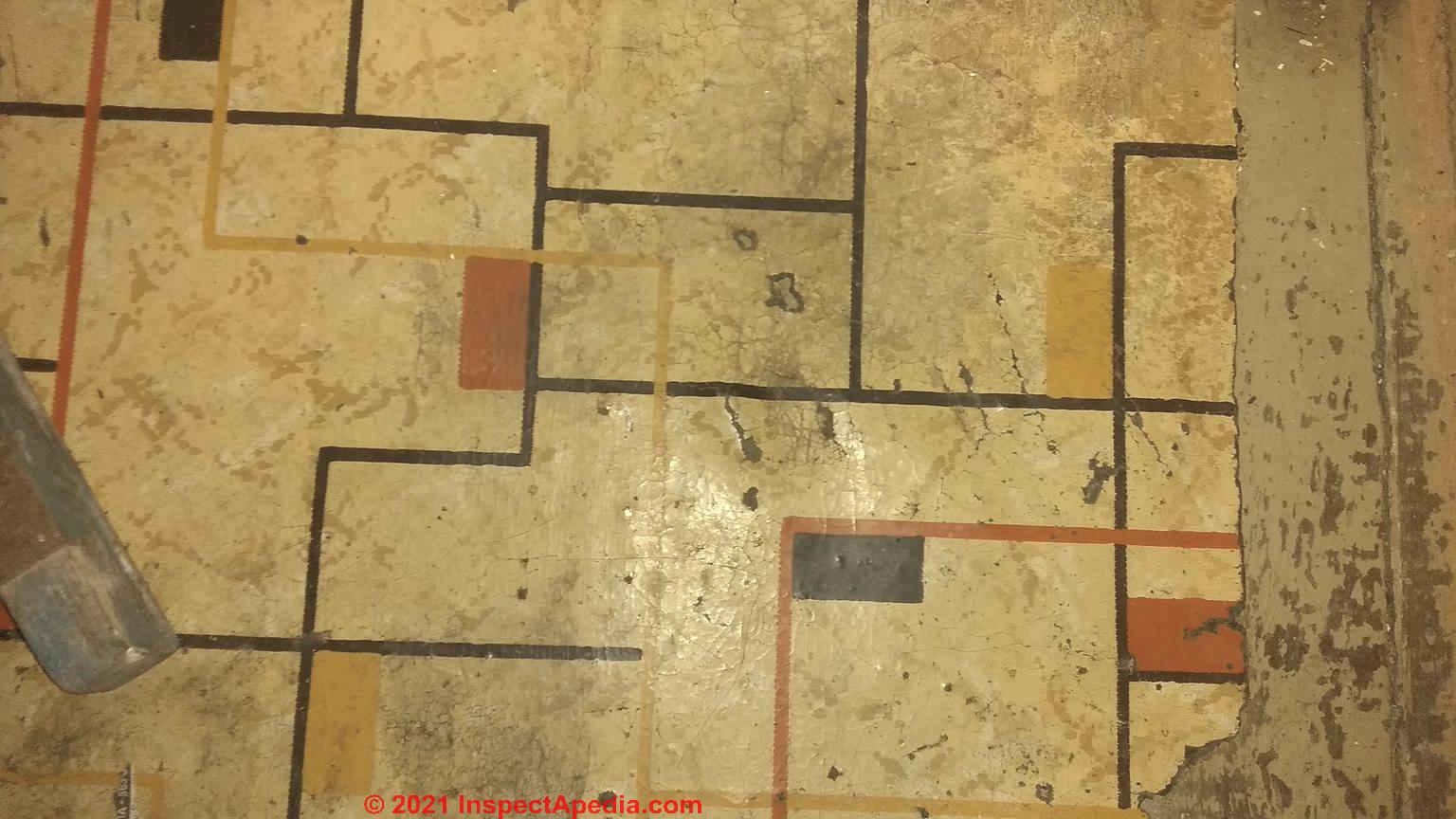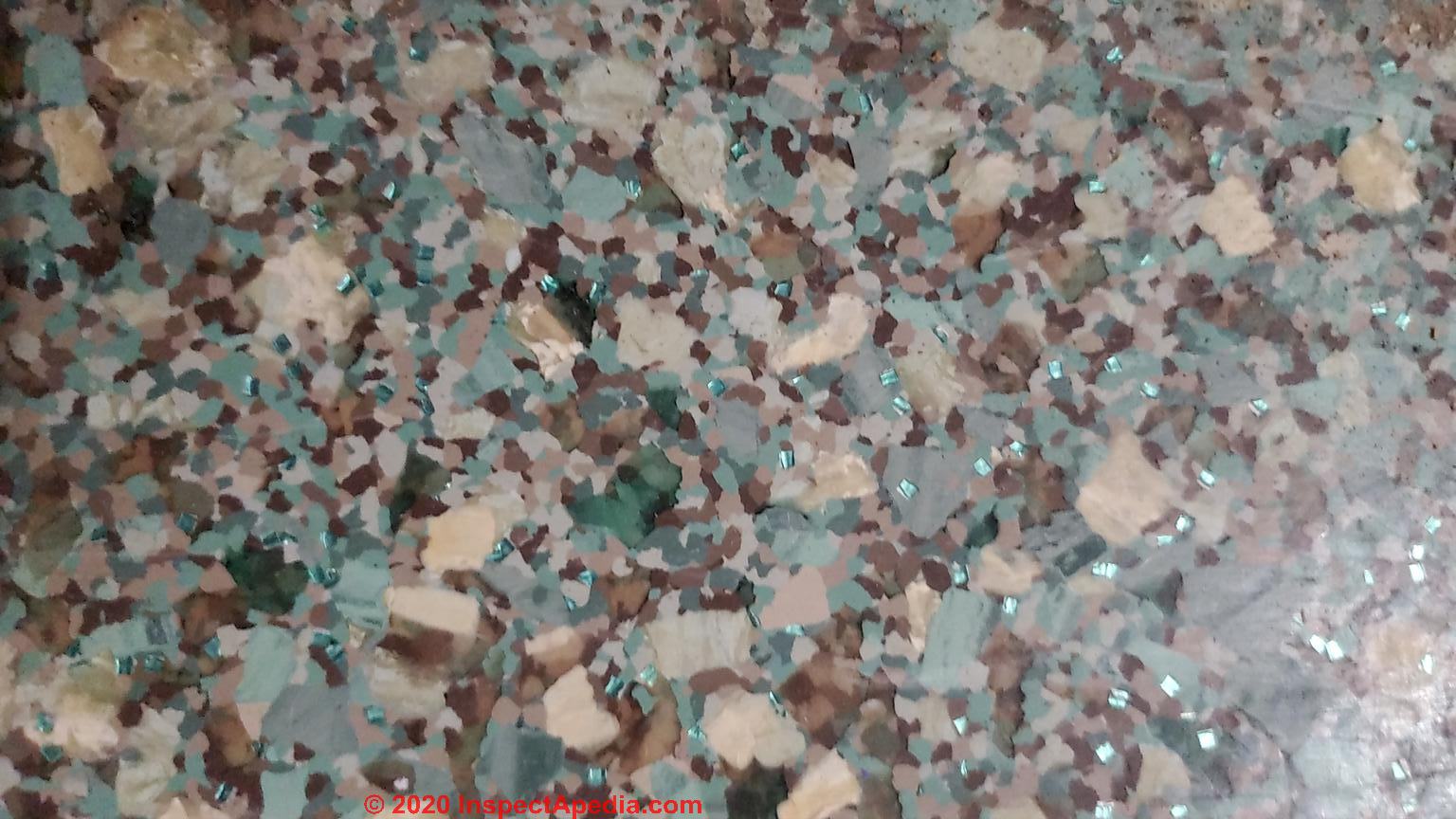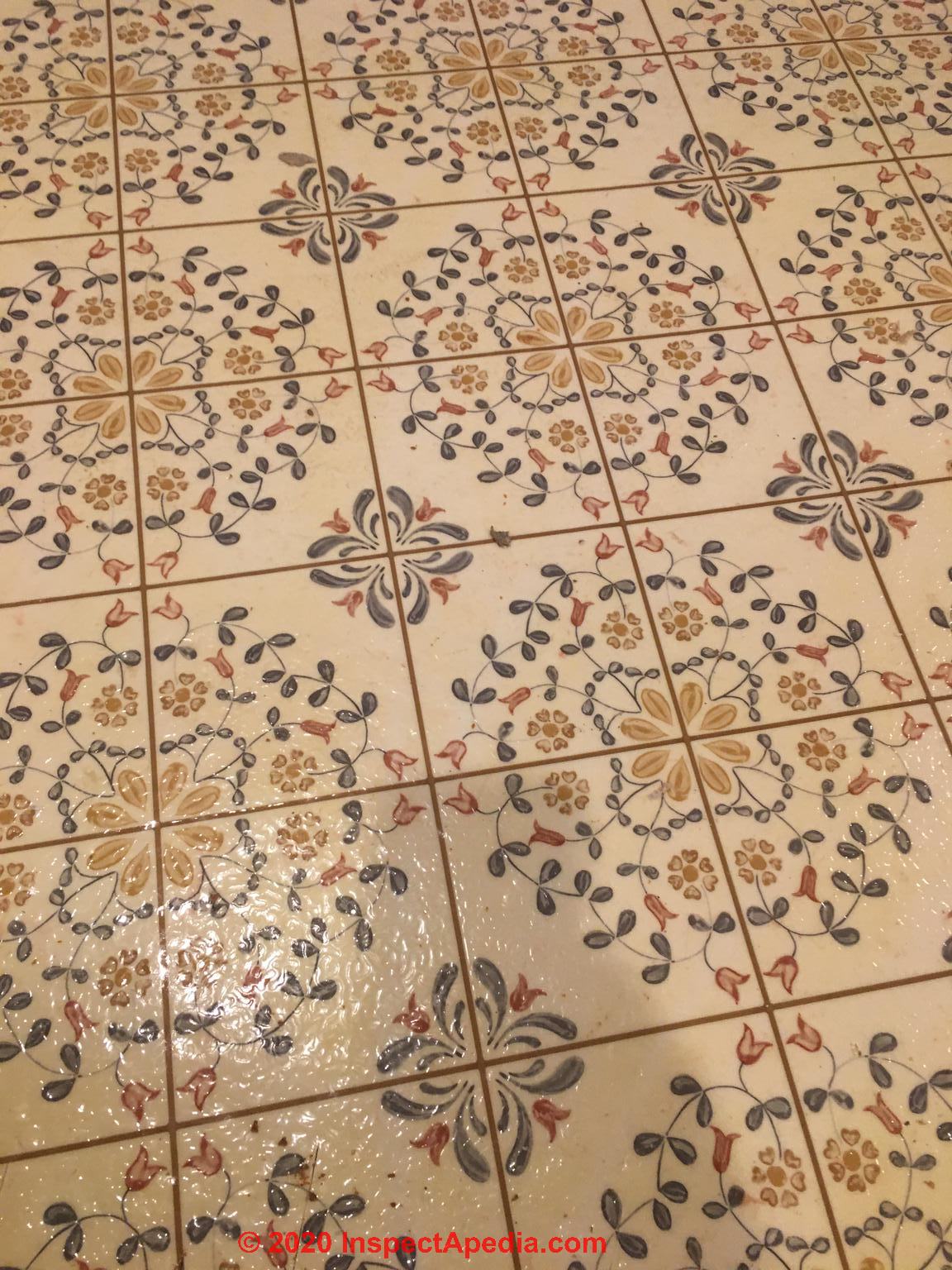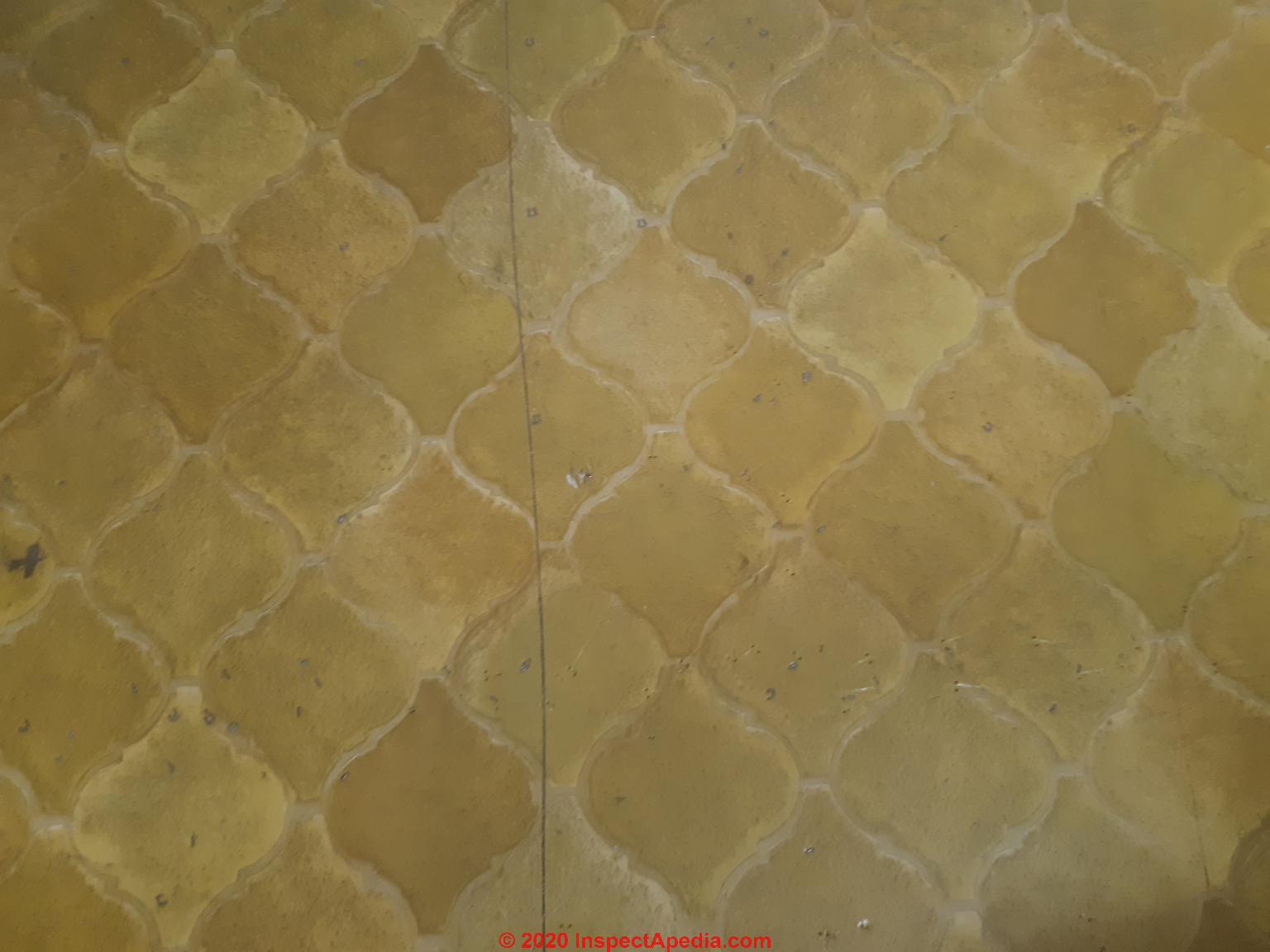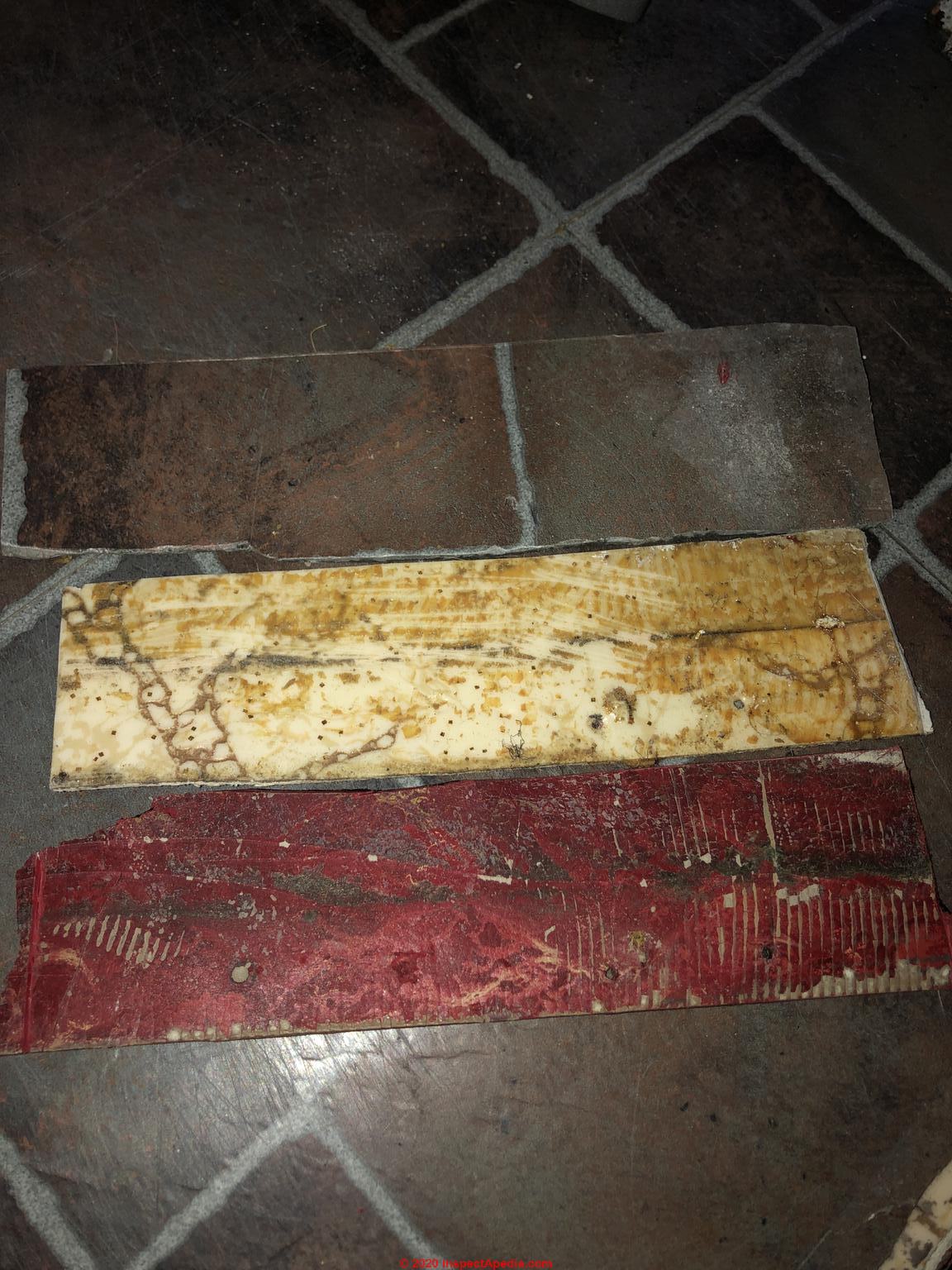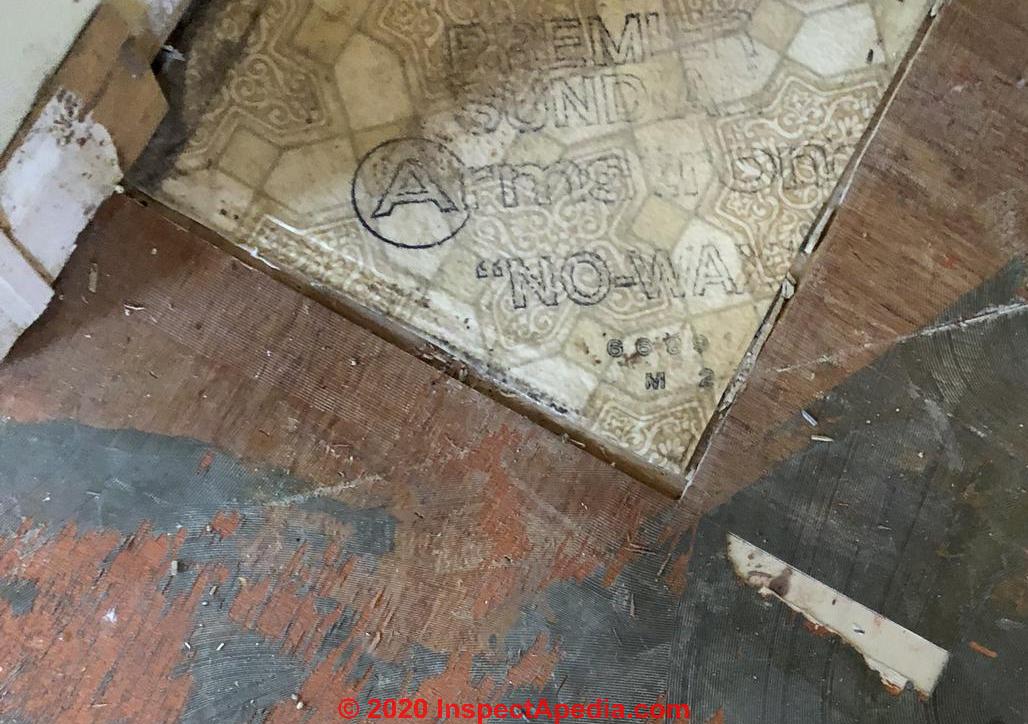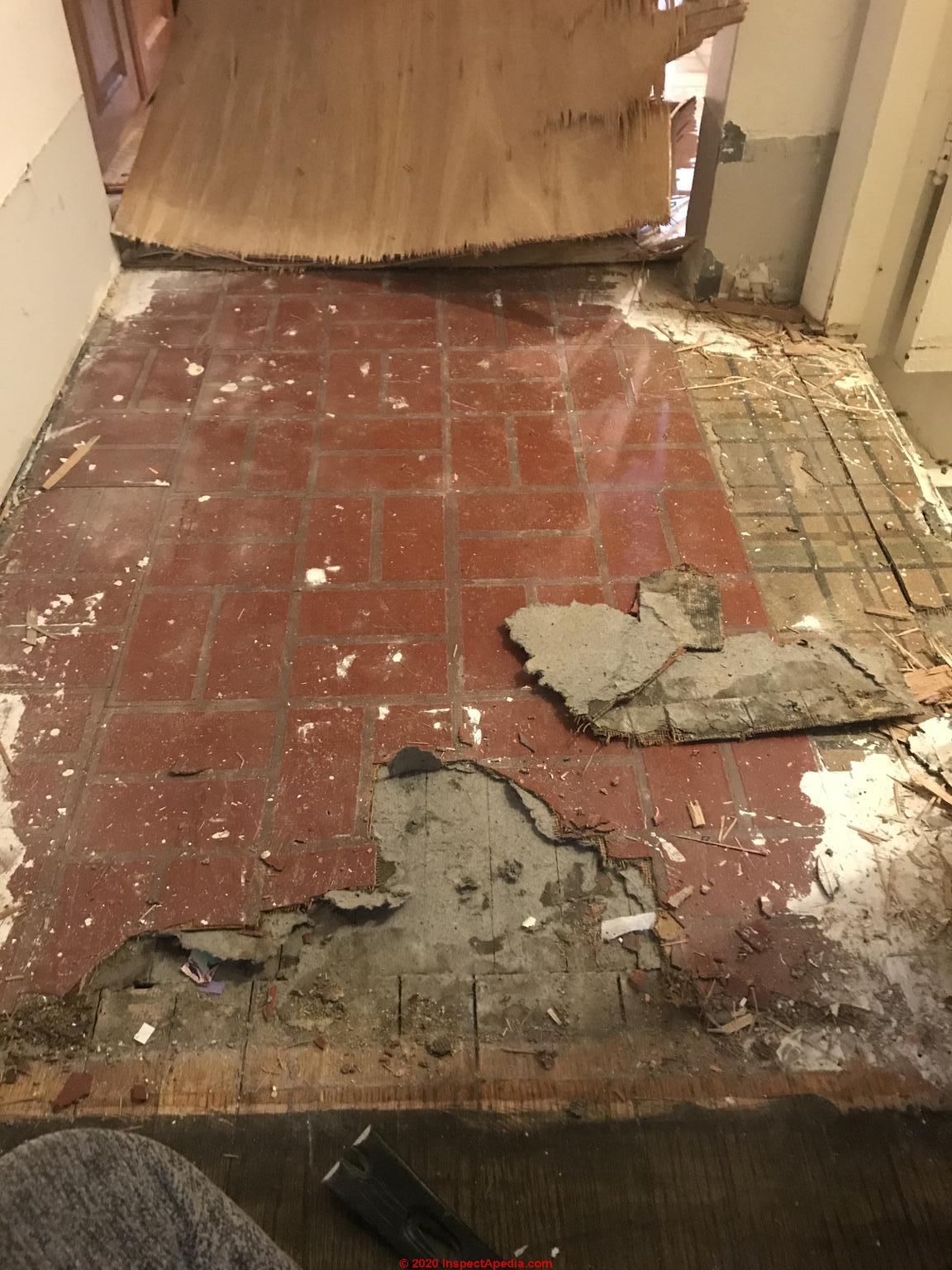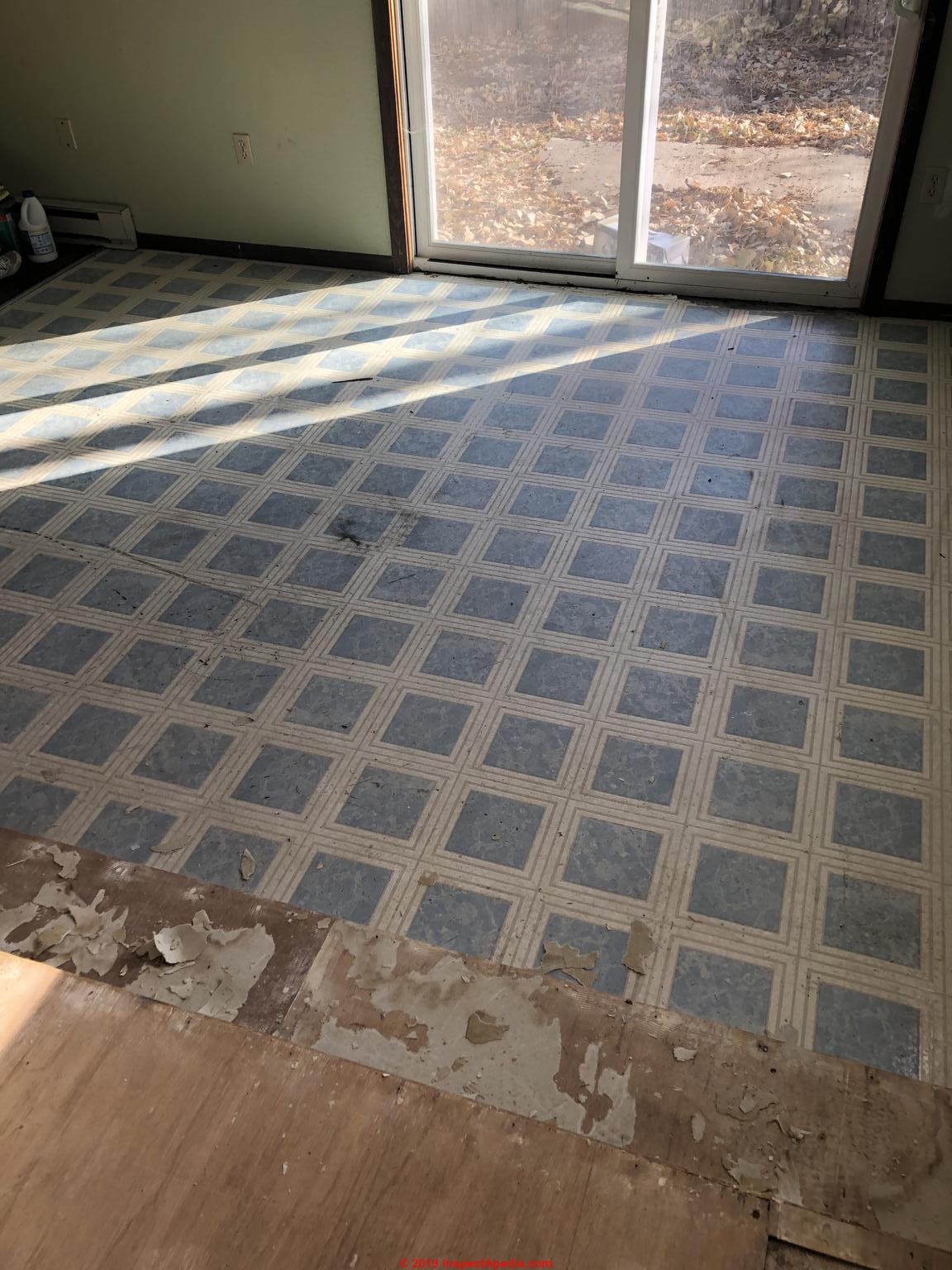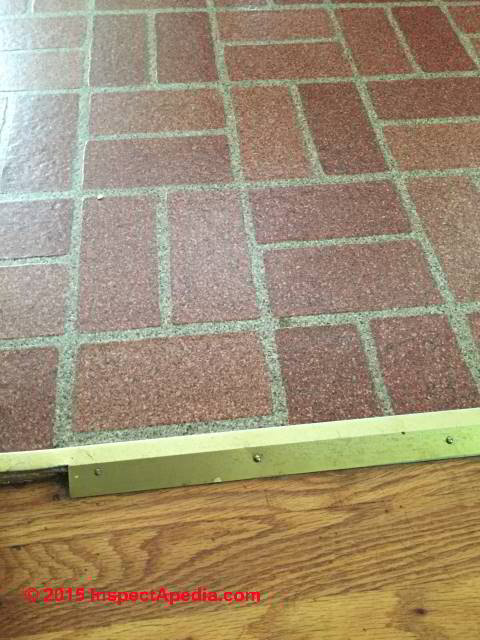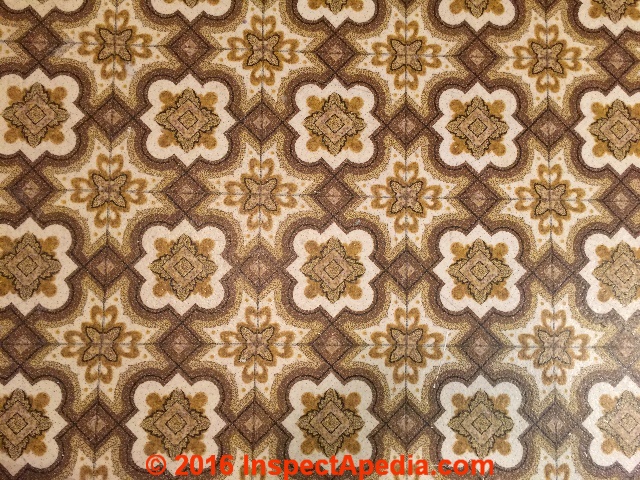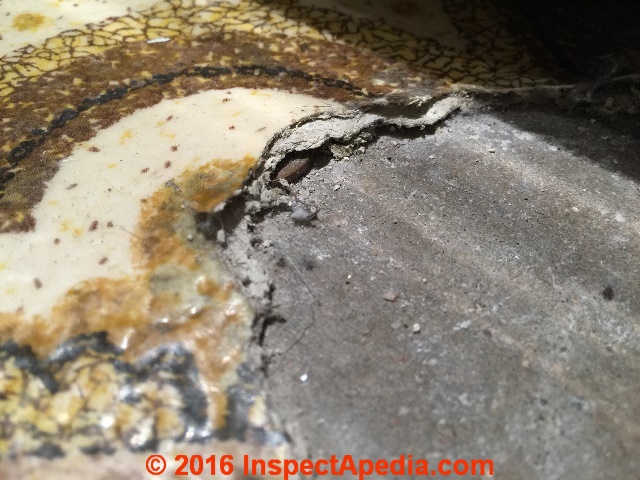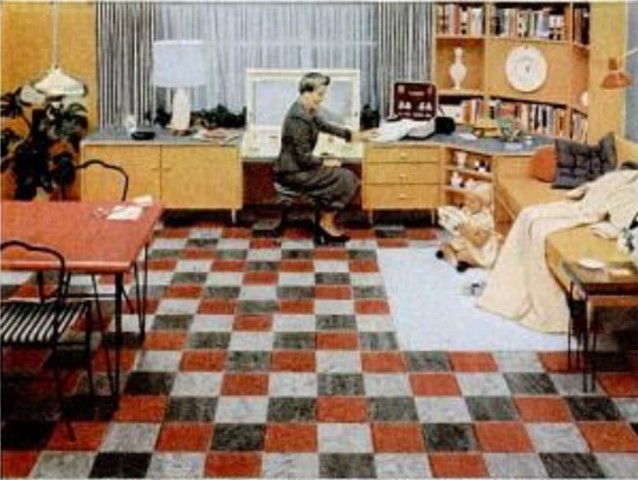 Asbestos-Containing Sheet Flooring FAQs
Asbestos-Containing Sheet Flooring FAQs
Q&A about how to identify & what to do about sheet flooring / resilient flooring containing asbestos
- POST a QUESTION or COMMENT about sheet flooring products that might contain asbestos
Asbestos-containing sheet flooring or resilient flooring FAQs:
Questions & answers about how to identify sheet flooring or resilient flooring that contains absbestos & what to do about asbestos in sheet flooring, resilient flooring or what some readers call "linoleum".
Page top photo: Congoleum flooring from a Congoleum sheet flooring catalog.
True linoleum flooring does not contain asbestos but some other sheet flooring products do. Asbestos was widely used as a filler in both asphalt-based and some vinyl based floor tiles of varying thicknesses, and extending to some thin, flexible self-adhesive backed tiles as well as some sheet flooring.
This article series describes sheet flooring products known to contain significant levels of asbestos. We also include photographs for identification of known asbestos-containing resilient sheet flooring as well as unknown flooring submitted for identification.
InspectAPedia tolerates no conflicts of interest. We have no relationship with advertisers, products, or services discussed at this website.
- Daniel Friedman, Publisher/Editor/Author - See WHO ARE WE?
FAQs about Asbestos in Resilient Flooring or Sheet Flooring
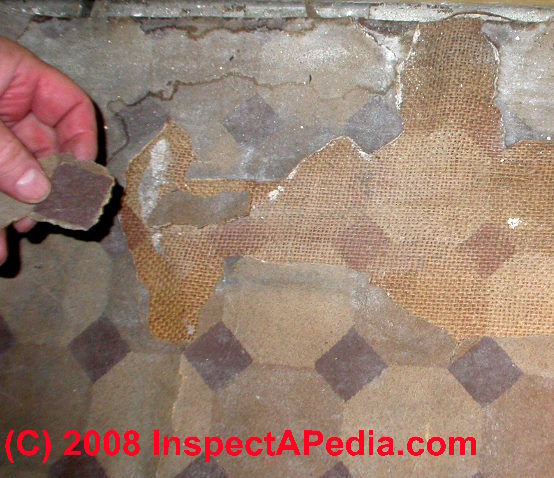 These questions and answers about identification of and asbestos content in older types of sheet flooring, linoleum, linoleum rugs, Armstrong sheet flooring, Congoleum and other products, were posted originally
These questions and answers about identification of and asbestos content in older types of sheet flooring, linoleum, linoleum rugs, Armstrong sheet flooring, Congoleum and other products, were posted originally
at IDENTIFY SHEET FLOORING TYPE, HOW TO - be sure to see that article.
The photos and questions are arranged in order from oldest floor coverings (used in the 1800's to early 1900's) to the present.
Shown at above/left, antique jute-backed sheet flooring. Included here for contrast, this is not an asbestos-flooring material.
Older sheet flooring products: example of floors that do not contain asbestos
The sheet flooring covering shown above is backed with burlap fabric is probably more than a century old.
We examined it in an non-public area of the Justin Morrill Homestead, a historic building in Vermont.
The material has not been tested for asbestos fibers, but where we see what is obviously a jute backing it's not likely that the product contained asbestos..
The possible origin of this product is discussed at Asphalt & Vinyl Floor Tile History - history, dates, and description of the production process and ingredients in asphalt floor tiles, asphalt-asbestos floor tiles, & vinyl-asbestos floor tiles 1900 to present.
Also see LINOLEUM & SHEET FLOORING
1930 Ohio gray brick pattern flooring test results negative for asbestos
No identifying marking on this floor, assuming to be original from 1930, located in northeast Ohio. Tested negative on the floor, backing, and mastic with SLGI. No asbestos found. 2023-02-02 by Nate
Reply:
@Nate,
Thank you so much for the great photo of that brick pattern and for the test results.
That helps us and other readers as well.
1950 New Hampshire star pattern flooring
Hello! I’m trying to find out what the star flooring is.
The house was built in New Hampshire in 1950. The stars appear to sit flush with hardwood floors.
I was hoping, if safe, I could restore it. But I believe I uncovered an asbestos tile (middle) so that will make it a bit more difficult!
Thanks! 2023-01-16
by Jess
Reply:
@Jess,
Both of those floor coverings are likely to contain asbestos.
But if the asphalt-asbestos bottom floor tile layer is in good condition, well adhered, not crumbling, you can still clean it and restore it. Don't use abrasives. Try a liquid wax stripper and liquid cleaners, and then coat the flooring with a clear semi-gloss floor coating.
12x12 cork style tiles likely contains asbestos
Pulled up carpet to find vinyl tile. Because it was 12 inch and very loosely attached, we started pulling them up. Light yellow adhesive, light grey backing, very thin tiles.
I was thinking only 9” would contain asbestos. My sister became worried, and now we are wondering. Most of the room was done with lifting easily, no breaking, but tearing up carpet tack strips cause some tearing and breaking.
Do you think we have a problem? 2022-07-31 by james deveney
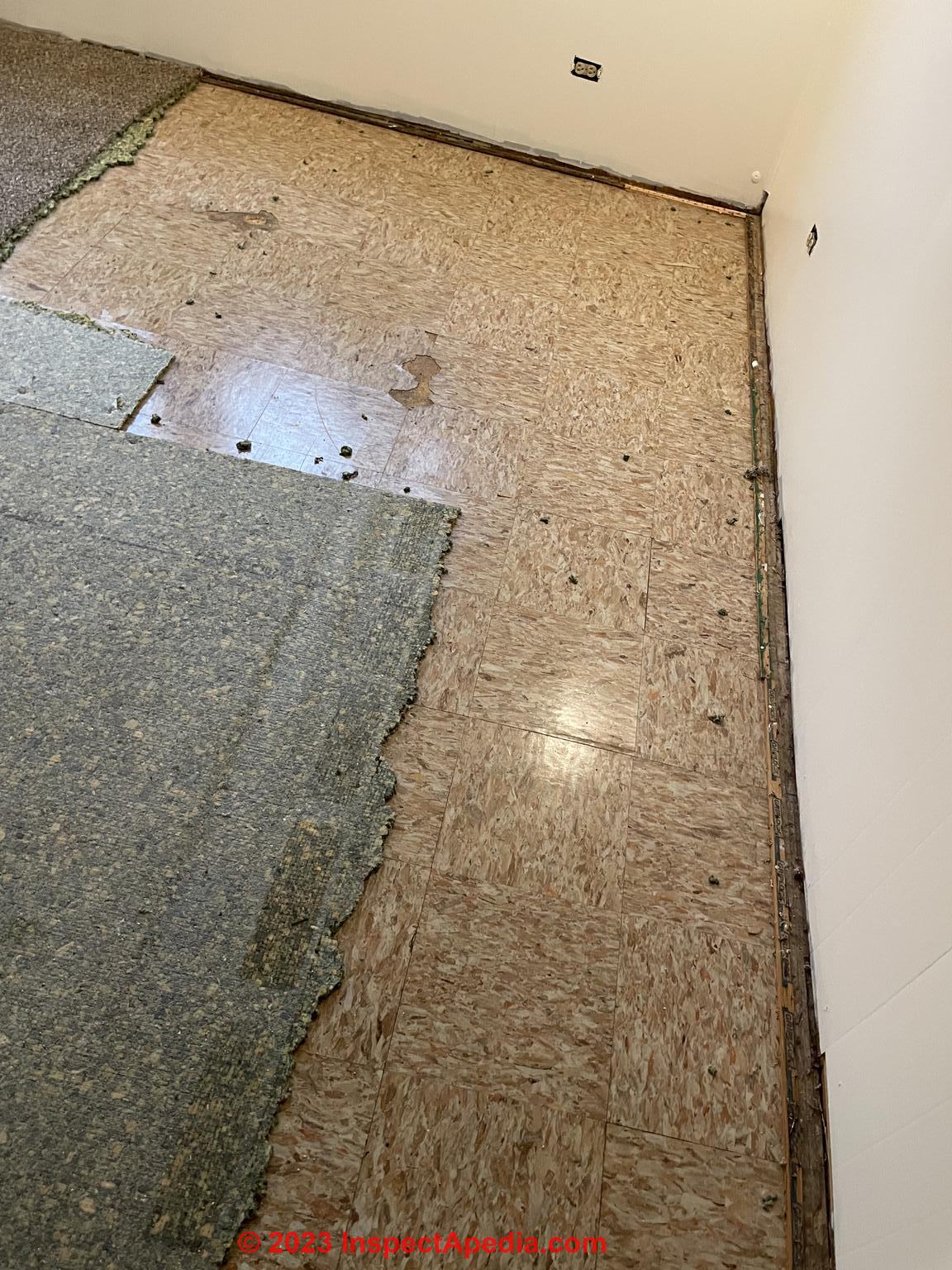
Mod reply:@james deveney,
While it's true that some 12-inch floor tiles from the "asbestos era" did not contain asbestos, it's a dangerous myth and simply wrong to claim that "only 9-inch floor tiles" contain asbestos.
Asbestos was found in asphalt-asbestos and vinyl-asbestos flooring materials of every imaginable shape and size and color.
Yours is a corkstyle flooring - likely to contain asbestos.
Where such a floor is intact, just pulling up carpet tack strips is not a large worry; damp wipe & HEPA vac any dust, and you're ready to install new flooring over the whole surface.Follow up: how do I removed breaking up asbestos tiles?
@InspectApedia-911,
Thank you for the info and the quick reply! New problem, it isn’t intact, many of them are coming up just by hand, whole, without breaking. We think it best to remove them. My biggest concern is the ones under the carpet tack. They will tear on removal.Is there a safe way to do this ourselves? The entire room aside from the outer ring with the tack would likely come up with no problem. Clear yellowed adhesive, has dried out. We are in New Mexico.
Reply:
@james deveney,
OK so if you can simply lift up intact tiles there's minimal hazardous dust.
If many tiles are breaking up you may need to set up dust control, use personal protective gear, remove the flooring, seal the surface, then install a new floor.
See ASBESTOS FLOORING REMOVAL GUIDE
IF just a few tiles are loose and others are secure, see
ASBESTOS FLOORING LEFT IN PLACE
and
ASBESTOS FLOORING HAZARD REDUCTION
for other steps you can take.
1986 Canada travel trailer sheet flooring
Does this flooring have asbestos it was installed in 1986 in Canada in a travel trailer from original manufacturer I think it’s linoleum. It is not tiles. 2022-04-06 by Concerned
Reply:@Concerned,
Follow up:
1986 is right on the edge of moving to asbestos-free flooring so it's possible that your flooring, if manufactured in the U.S. or Canada before that year, may contain asbestos; in sheet flooring it'd be the backing that's most-likely to contain asbestos.@Inspectapedia Com Moderator, do you have any idea which brand it could be I can’t see anything like it in any of the pictures on this site. I’ve searched the web as well with no luck. I will be taking a sample to get tested.
Reply:
@Concerned,
Sorry but no. There are literally thousands of sheet flooring designs, many of which are similar even though made by different manufacturers.
Please let us know your test result.
Also see
DOES THIS FLOOR CONTAIN ASBESTOS? - 5 easy questions to tell if your FLOOR probably contains asbestos - - live link at the Recommended Articles list.
Red clay substance under carpet is disintegrating red underlayment
We recently began ripping up carpet in our home, we are renovating. And found this red clay like substance under the carpet. We now have a concern for asbestos. What do you think this is? 2022-04-06 by Blair
Reply:@Blair,
That looks like disintegrating and quite old carpet or flooring under surface of an underlayment. Some of those products contain asbestos.
More help is at
DOES THIS FLOOR CONTAIN ASBESTOS?
https://inspectapedia.com/hazmat/DIY-Asbestos-Floor-Test.php
Asbestos concerns in tile and in mastic adhesive
Just bought a 1960s and have been pulling up the flooring that’s laid on the subfloor. Just wondering if it might have asbestos. There’s glue on top of the flooring so it’s hard to see the pattern. I can send another photo with the flooring pattern. 2022-03-12 by Brittany Dimitroff
Reply:@Brittany Dimitroff,
Please do post a photo of the pattern if you can (one photo per comment but as many comments as you wish).The flooring, especially its backer, and the mastic adhesive may both contain asbestos.
From this photo, it is impossible to know if it contains asbestos but I would treat it as presumed-to-contain-asbestos material.
In the meantime, short of testing, you can make a reasonable *guess* at whether or not the floor contains asbestos by answering the few easy questions found at:
DOES THIS FLOORING CONTAIN ASBESTOS? - 5 easy steps that can help you make a reasonable guess at whether or not the floor you ask about contains asbestos.
If the floor must be removed then see the asbestos floor removal and asbestos hazard reduction articles found in the ARTICLE INDEX at the end of any of these pages.
Armstrong's Spatter Linoleum sheets (No. 5001 "Mantilla Black") in Essex, UK
Hello, found what I believe is Armstrong's Spatter Linoleum sheets (No. 5001 "Mantilla Black") adhered to hardwood floorboards on the ground floor in the crawlspace underneath our stairs. House was built in 1894 on the outskirts of Chelmsford, Essex, UK.
There is a layer of tan paper, almost like a soft cardboard, backing the tiles with a black sticky layer of what looks like tar adhering it directly to the wooden floorboards. Any feedback as to possible asbestos would be greatly appreciated! 2022-01-24 by Scott
Reply:@Scott,
It's true that some flooring backers and some flooring mastic adhesive contained asbestos up into the 1980s - that's beyond the age of the flooring in your photo.
see also
DOES THIS FLOOR CONTAIN ASBESTOS? - 5 easy questions to tell if your FLOOR probably contains asbestosA guess of 1950s or perhaps early 1960s for the era of your chip/spatter pattern sheet flooring is reasonable. Its backer and/or its black mastic adhesive may also contain asbestos.
In addition to the 5 Easy Steps that we referred you to earlier, keep in mind, the safest and least costly approach is to leave the flooring alone, in place, and to cover it with new material.
If the floor is in poor condition or must be removed then see the asbestos floor removal and asbestos hazard reduction articles found in the ARTICLE INDEX at the end of any of these pages.
Does this filigree flooring contain asbestos?
Does the sheet flooring in the attached photo contain asbestos? It is in our home that was built in 1978. This sheet flooring is underneath ceramic tile. We plan to remove the ceramic tile, which may disturb the sheet flooring. 2021-12-28 by Chad
Reply:@Chad,
That flooring might contain asbestos if it was installed in a building in North America before 1987. From a photo one can’t answer your question with certainty. Popular flooring patterns were continued, without asbestos, after 1986.Have a sample of the flooring tested, or you can make a reasonable *guess* at whether or not the floor contains asbestos by answering the few easy questions found at:
DOES THIS FLOORING CONTAIN ASBESTOS? - 5 easy steps that can help you make a reasonable guess at whether or not the floor you ask about contains asbestos.
https://inspectapedia.com/hazmat/DIY-Asbestos-Floor-Test.php
Asbestos is safe and legal to remain in homes or public buildings as long as the asbestos materials are in good condition and the asbestos can not be released into the air. - US EPA
The safest and least costly approach is to leave the flooring alone, in place, and to cover it with new material.
If the floor is in poor condition or must be removed then see the asbestos floor removal and asbestos hazard reduction articles found in the ARTICLE INDEX at the end of any of these pages.
1930s basement flooring is brittle and cracking
I just bought a home that was built in 1930. In the basement, underneath the porch crawl space, I found old sheet flooring that is brittle and cracking. It appears to have never been glued down to a floor, but was possibly extra unused sheets (not tiles).
How do I know if it contains asbestos and particles are being released into the air? The floors in the main area of the house are wood or carpet on top of wood. It is possible that there was flooring on top of the wood at some point. 2021-11-09
by Debra
Reply:
@Debra,
If you can pick up or roll up flooring without chopping, grinding, sawing, or otherwise creating a dusty mess, it's not likely that you're releasing a meaningful amount of flooring debris particles into the nearby air.
Beyond that, you might want to see
DOES THIS FLOOR CONTAIN ASBESTOS? - 5 easy questions to tell if your FLOOR probably contains asbestos -
Live link given above at the section on Recommended Articles.
Age and design are indicators of asbestos
Does this tile contain asbestos? Contractor started to break it up already. House was build in 1953 but have no idea when it was installed. 2021-06-12 by Tiffany Pisani
Mod reply:@Tiffany Pisani,
That floor is likely to contain asbestos.
1950s house with different sheet flooring patterns
Late 1950s house; found this sheet under a newly installed plank flooring. I was unable to find this tile in the library. Are you familiar? Any thoughts if this may contain asbestos? Thanks. 2021-04-21 by Maribeth
Late 1950s house with this sheet in basement bath. I thought the style looks a little 80ish. I was unable to find this tile in the library. Are you familiar? Any thoughts if this may contain asbestos? Thanks.
Reply:@Maribeth,
Because popular floor patterns were made by more than one manufacturer, and because popular flooring patterns were produced across and past years when asbestos was a common ingredient, one cannot safely say, on a photo alone, whether or not a particular floor tile or sheet flooring pattern contains asbestos.
Short of having a sample of the flooring tested, you can make a reasonable *guess* at whether or not your floor contains asbestos by answering the few easy questions found at
DOES THIS FLOORING CONTAIN ASBESTOS? - 5 easy steps that can help you make a reasonable guess at whether or not the floor you ask about contains asbestos.
At the very least, if you can establish the date that the flooring was made or installed then, depending on the country where the flooring was made (and usually where it's installed) you can know if it's an asbestos-candidate.
If that leaves you with suggestions or questions do let me know.
Possible asbestos in antique linoleum backer
Wondering if this linoleum is asbestos? Or if you know brand/year? Thanks in advance! 2021-03-17
by Amy
@Amy, you'll see a close match to your linoleum at LINOLEUM & SHEET FLOORING https://inspectapedia.com/interiors/Linoleum_Flooring.php
and you'll want to read
LINOLEUM ASBESTOS CONTENT? https://inspectapedia.com/interiors/Linoleum-Asbestos-Content.php
in that article.
Speckled spatter pattern sheet flooring
Be careful with speckled spatter pattern sheet flooring, I would not assume it is asbestos free! I have it in my kitchen (under other flooring), after coming to this page I still decided to have it tested, and it contains a low amount (7%) of asbestos.
In the small amount I pulled up for testing I didn't find an Armstrong mark but it looks very similar to Tuscany Tan No. 5007. It has a dark grayish paper backing. The mastic used with it was black and it also contained a low amount of asbestos. 2020-12-23
by Keel M
Reply:
Thank you for the helpful comments Keel.
I agree completely.
1973 New Mexico bathroom flooring
My home was built in 1973 in NM, with this flooring in a bathroom. I thought it was original, but some of it lifted up and tore, and it feels newer, not embrittled, not flaking. Greyish paper under the top layer with a thick layer of white adhesive or mortar underneath.
There appears to be some orange discoloration on the edge by the tub, I presume from water damage. Can you tell if this is newer flooring, or could it be from the asbestos age? 2020-12-19 by Matt
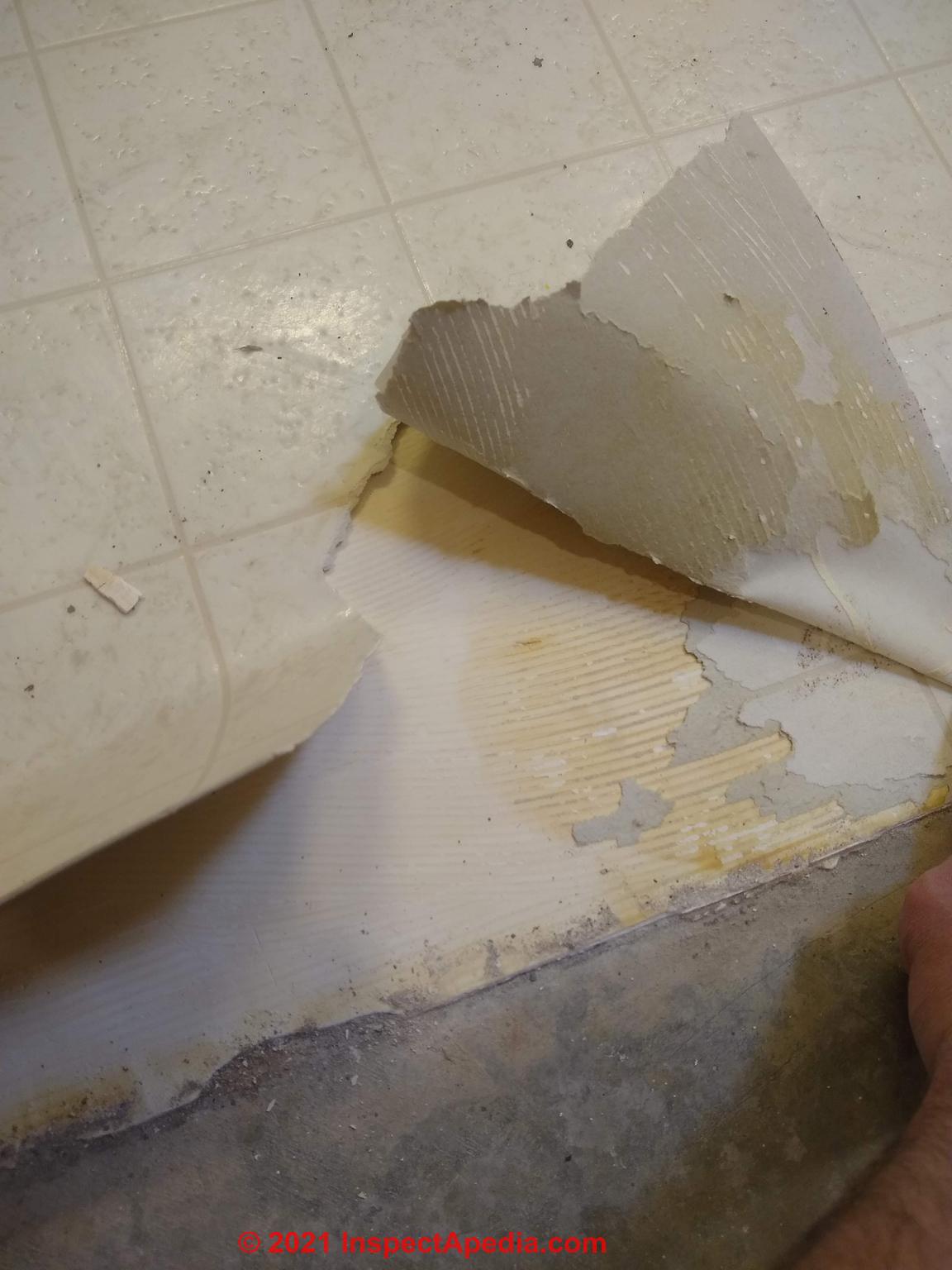
Reply:
Matt, it'd be common for that flooring to contain asbestos, at least in its whitish backer.
1962 Canadian sheet flooring with blue backing
Home built in 62. Canada. Pulled up old carpet to find this sheet flooring. Scraping away adhesive I tore it in several places. The front is textured. The backing is blue and fibrous. Looks like blue construction paper. What do you think? Does it contain asbestos? 2020-07-31
by Daniel Hogan
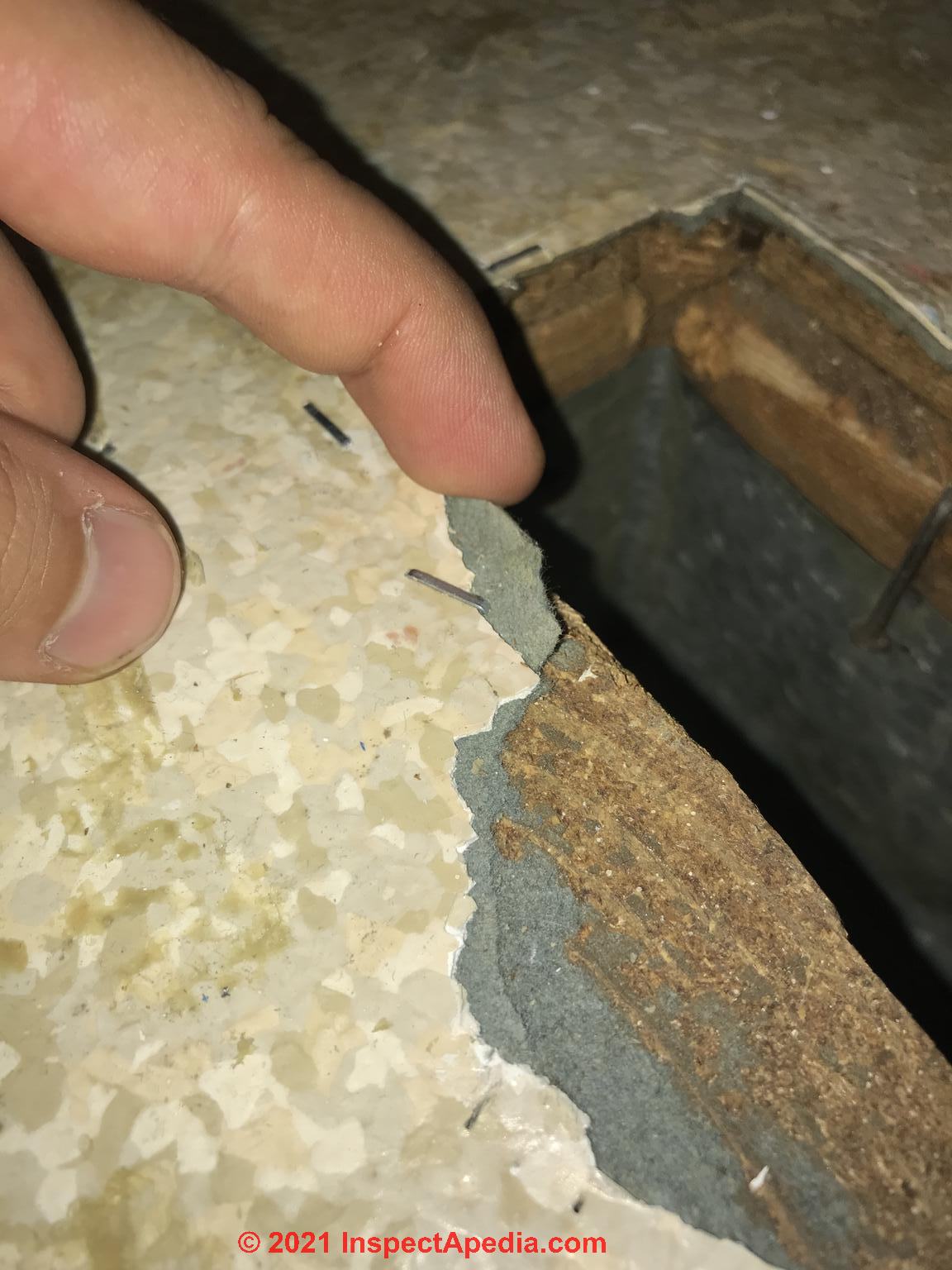
Reply:
Yep I'd expect that Canadian 1960's flooring to contain asbestos; To know for certain you'd need to have a sample tested.
Possible asbestos in asphalt-felt-backed sheet flooring or "linoleum"
 Hi, I took up a floor yesterday and am now having a panic that it may have contained asbestos. It was large sheets of a vinyl floor, loosely laid over floor boards, not stuck down but had a carpet over. I think the carpet was laid in the late 70s and the vinyl is older.
Hi, I took up a floor yesterday and am now having a panic that it may have contained asbestos. It was large sheets of a vinyl floor, loosely laid over floor boards, not stuck down but had a carpet over. I think the carpet was laid in the late 70s and the vinyl is older.
The house was built in the 1920s. I’ve sent off for an asbestos testing kit but would welcome any advice, particularly what I should do now if it likely to be asbestos.
The sheet itself is quite thin with a pattern on top, black in the middle and a red bottom. I could see no makers mark. As I removed it, it would bend then quite cleanly break on the fold line. Many thanks. 2020-12-31 by Rox
Reply:
Rox,
Some back asphalt-impregnated paper-backed sheet flooring contains asbestos.
Use Damp wiping and HEPA vacuuming to clean up.
The presence of known asbestos-containing flooring does not mean we should panic nor that we should undertake an expensive and dangerous asbestos removal project.
Asbestos is safe and legal to remain in homes or public buildings as long as the asbestos materials are in good condition and the asbestos can not be released into the air.
Generally the safest approach is to leave such flooring alone and to cover it with a coating or with another layer of flooring.
Possible asbestos in peel-and-stick vinyl flooring in a 1994 house?
We had a small flood in our kitchen and had to pull up the laminate flooring. We found these tiles underneath. They are Armstrong and have a item #22130. House was built in 1994. At this point asbestos products were not supposed to be used but I just wanted to be really sure. Here is an image of the vinyl
Tile. It is a peel and stick. 2020-12-29
by Scott

Reply:
You're right. Asbestos would not be expected to be present in peel and stick flooring made and installed in North American in 1994.
1963 sheet flooring
Hi, We found that one of our bathroom's sheet flooring contains asbestos. Our house was built in 1963, and I can't find anything about the other sheet flooring we have. Does anyone recognize this one? Thanks for this resource! 2020-12-26
by Emily

Reply:
Emily
That flooring looks a bit later to me than the 1960s but certainly could contain asbestos.
To know for sure course you have to have a sample tested.
For reducing the potential asbestos Hazard See the advice offered at
ASBESTOS FLOORING HAZARD REDUCTION
Asbestos risk in 1960s Mobile Home sheet vinyl flooring
Under a layer of newer linoleum was another layer and under that was a blue felt lining. I suspect this is original to the mobile home 1966 . What’s the chance of that blue lining contains asbestos? 2020-12-22
by Joan

Reply:
Joan,
Thanks for the question and photo; to know for certain you'd need to have these flooring materials tested for asbestos, but for a 1966 sheet flooring in a mobile home it would be perfectly reasonable to treat the flooring and its backer or asphalt-impregnated felt underlayment as "PACM" - presumed asbestos-containing materials.
Some felt-backed sheet flooring contains asbestos
Our home was built in 1900. We bought it a few months ago. We are wanting to expose the wood floors but we found this flooring on the threshold between the carpet and kitchen vinyl tile. It looks like a linoleum of some sort because it’s all one piece. 2020-11-19
by alisonvellinga
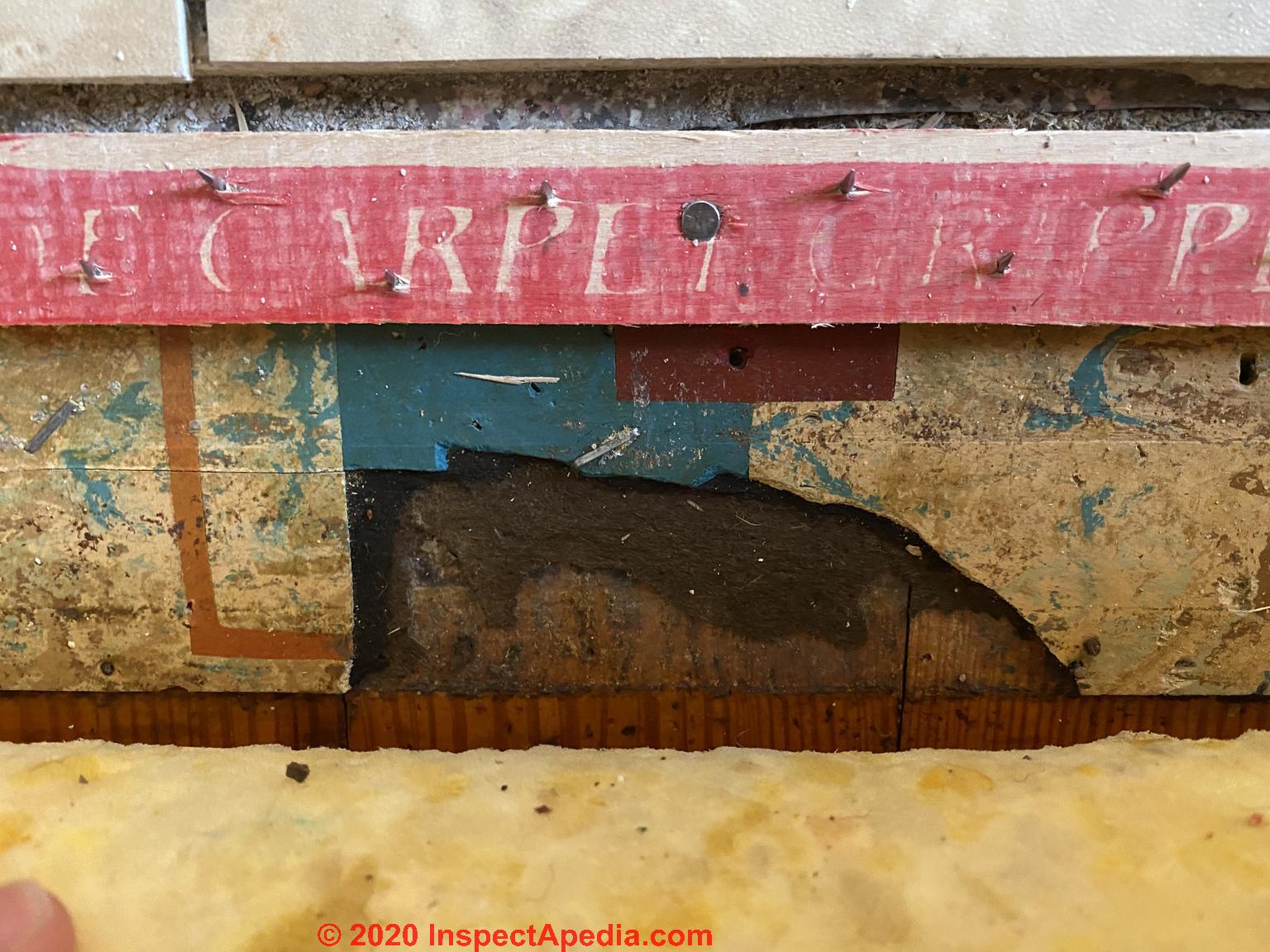
Reply:
Certainly some felt-backed sheet flooring contains asbestos. Treat it as presumed to contain asbestos or have a sample tested.
Follow up:
Ok, thank you. Do you have any recommendations where to send it? I don't have anyone near me that deals with asbestos.
Reply:
Sure, Alison; In the Recommended Articles at the end of this page
see
ASBESTOS TESTING LAB LIST
1959 flooring contain asbestos?
Does this flooring from 1959 contain asbestos? 2020-11-15 by Mrsm
Reply:
Certainly asbestos in that floor is a good possibility given its age. You should treat it as presumed to contain asbestos.
Also see
DOES THIS FLOOR CONTAIN ASBESTOS? - 5 easy questions to tell if your FLOOR probably contains asbestos
https://inspectapedia.com/hazmat/DIY-Asbestos-Floor-Test.php
Thin plastic contact paper not likely to contain asbestos
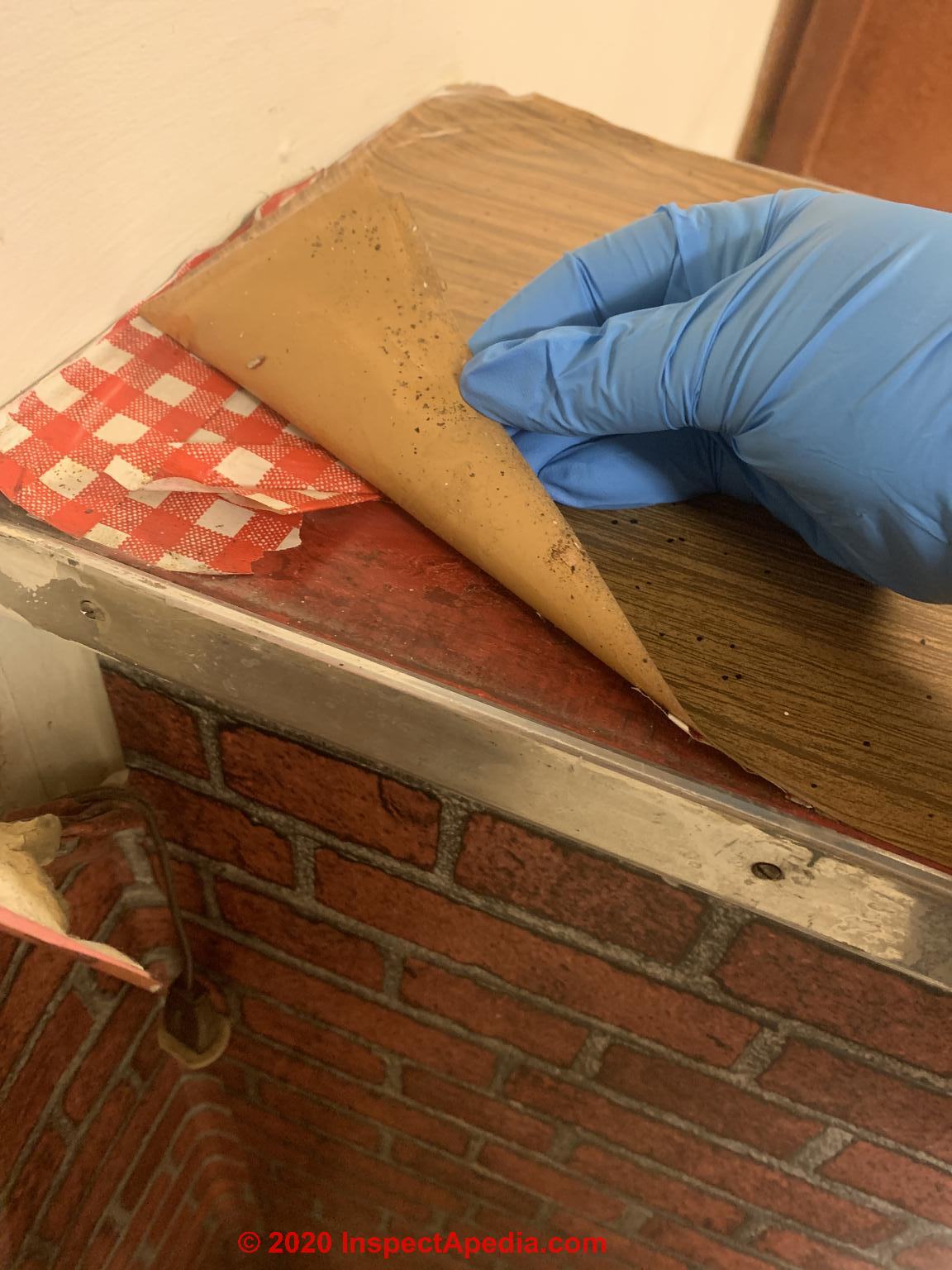 Hi, my husband and I just bought a home that was originally built around 1957.
Hi, my husband and I just bought a home that was originally built around 1957.
The family added a back half to the original home in about 1974.
This is the add-on bar/island that was built in the home. I started to pull up the paper or whatever this is and I could smell what seemed to be a strong glue smell.
It reminded me of the smell of a Polaroid when the backing comes off (the part where the chemicals are kept to help it develop after you take the picture)
Does this have asbestos?
The home has a lot of what looks like vinyl or linoleum (I honestly can’t tell). 2020-11-06
by Paris
Reply:
That looks to me like contact paper, not an asbestos flooring product.
Asbestos possible in a 1980 vinyl sheet flooring product
Is this asbestos? House built 1980 .
Reply:
Joe: a 1980 vinyl floor may indeed contain asbestos.
With no other information than the year, it'd be helpful to see DOES THIS FLOOR CONTAIN ASBESTOS? - 5 easy questions to tell if your FLOOR probably contains asbestos
inspectapedia.com/hazmat/DIY-Asbestos-Floor-Test.php
Does my 1964 house floor contain asbestos?
Our home was built in 64… And we discovered in our basement that we have 6 x 6 white and green tile, do they have asbestos… And should we pull it up or just paint over it and lay more carpet? 2020-10-12
by Rebecca
Reply:
Rebecca
With no other information than your text, it'd be helpful to see DOES THIS FLOOR CONTAIN ASBESTOS? - 5 easy questions to tell if your FLOOR probably contains asbestos - here's the link:
https://inspectapedia.com/hazmat/DIY-Asbestos-Floor-Test.php
to make an educated guess at the asbestos question. Please take a look and don't hesitate to post photos (one per comment) or to ask follow-up questions if any of that is unclear.
If the jute linoleum is not asbestos containing, can I have any sureness that the felt is not as well?
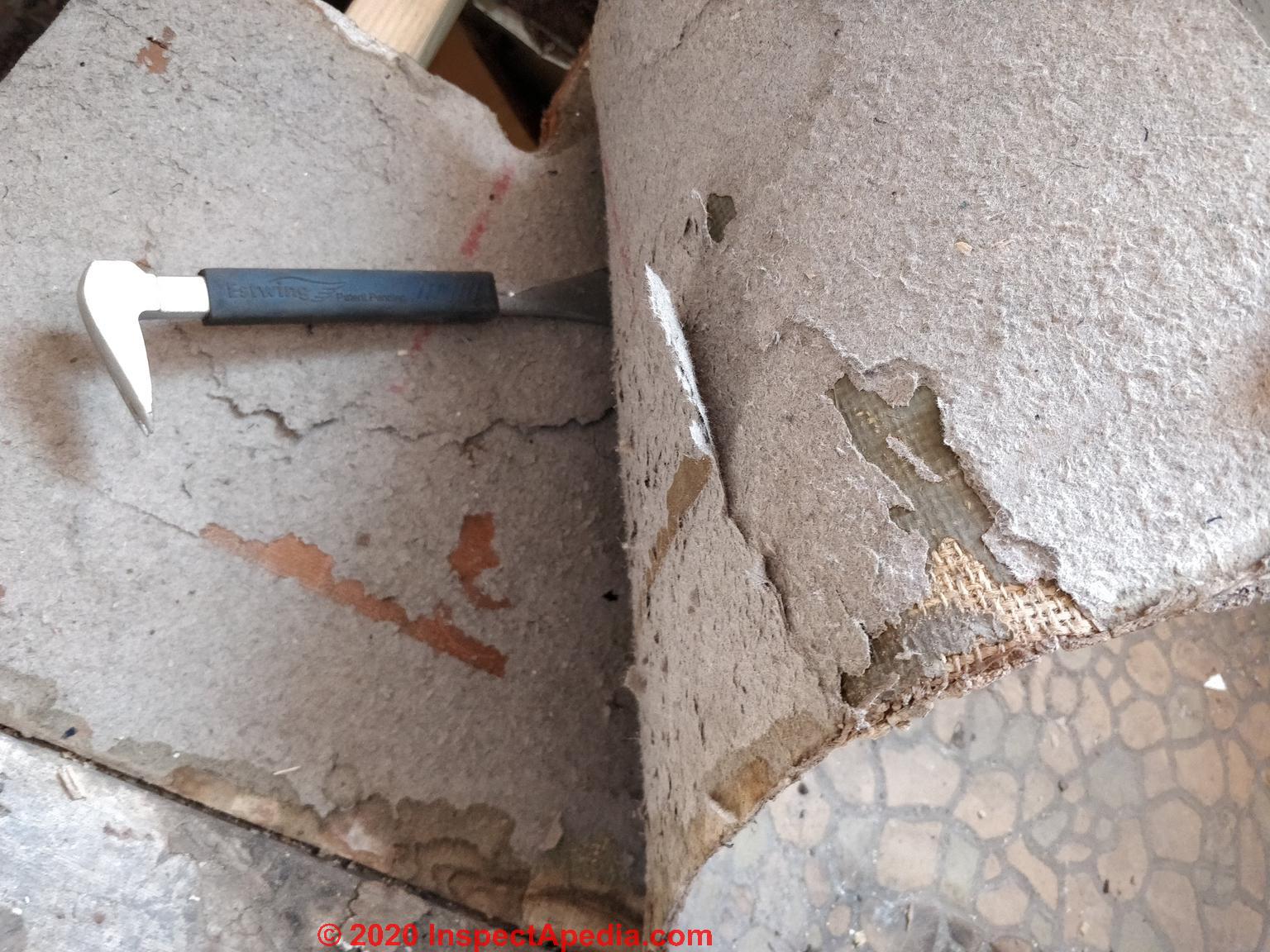 I am working on my 1910 house, and I've been removing some old linoleum, I have 4 different types that have had a jute backing, which I am not worried about, but in the bathroom, underneath where the tub used to sit, is an old pebble pattern jute backed linoleum.
I am working on my 1910 house, and I've been removing some old linoleum, I have 4 different types that have had a jute backing, which I am not worried about, but in the bathroom, underneath where the tub used to sit, is an old pebble pattern jute backed linoleum.
The jute is clearly visible, but I am slightly concerned about the grey felt backing.
If the jute-backed linoleum is not asbestos containing, can I have any sureness that the felt is not as well? 2020-08-29 by Justin
Mod reply:
No, Justin, not in my view.
Certainly some white or gray papery backer on 1970s and 1980s sheet flooring contains asbestos.
How do we handle 1977 flooring that we sawed through?
My husband sawed through our flooring underlayment to remove 2 layers of flooring and we found this yellow gold sheet vinyl underneath. Our house was built in 1977, and we wanted to know if this sheet vinyl might contain asbestos?
We plan to lay a cork underlayment and then install a floating locking vinyl plank flooring.
We are wondering if we should now also use a sealer of epoxy to cover the saw marks on the damaged sheet vinyl as a precaution. 2020-06-23 by Deana
Reply:
I would treat that floor as presumed to contain asbestos.
As you're going to install flooring over the old floor, high-adhesive foil tape over the saw marks may be sufficient and easier and quicker.
OK to cover remaining flooring adhesive or backer with new floor mateirals
 Hello! I have a follow up question from my picture yesterday. I can’t find my picture. You said that it could be asbestos. There is still a layer of the tile backing that won’t come up. It’s almost a paper/cardboard. Can we lay the Underlayment on top of that or do we need to seal it? 2020-06-05 by Kd
Hello! I have a follow up question from my picture yesterday. I can’t find my picture. You said that it could be asbestos. There is still a layer of the tile backing that won’t come up. It’s almost a paper/cardboard. Can we lay the Underlayment on top of that or do we need to seal it? 2020-06-05 by Kd
Reply:
KD
As long as the layer of tile backing is secure and smooth enough that it won't cause trouble with the new flooring being installed over-it, it's fine to place underlayment and then new finish flooring.In my opinion and experience there is just no reasonable chance that the old flooring can transmit potentially hazardous particles up through layers of new flooring installed over it.
I ran number one flooring backer production machine and the asbestos was mixed in a tank
i ran number one machine and the asbestos was mixed in a tank as i set under it with all the dust falling on me i fell there should some kind of a law suit or compassion to the people that was exposed to the asbestos dust.
Reply: where to find lists of asbestos-producing companies and settlement trust funds
Gary,
There have been class action lawsuits and various trust funds have been set up to give at least some financial support two people injured by asbestos exposure, especially workers.See details at ASBESTOS PRODUCING COMPANIES & TRUSTS
Asbestos in Armstrong square-chip sheet flooring from early 1960s
 I am concerned because of the exposure of the "presumed to contain asbestos" vinyl flooring edge due to water leaks under the linoleum.
I am concerned because of the exposure of the "presumed to contain asbestos" vinyl flooring edge due to water leaks under the linoleum.
Water has caused the flooring to shrink and curl away from the tub edge exposing about 1/2 inch of brown fibers and mold as well.
The flooring is in a rental apartment which was built in the early 1960's. 2020-06-01 by Jean
Reply:
Jean
We have tested a sample of a flooring of this pattern, dating from a US home built in the early 1960s, and test confirmed that the floor contains asbestos, principally in its backer.
An easy way to put yourself at ease might be to simply run a bead of appropriate sealant along the flooring edge. That will keep out water and thus reduce the chance of flooring damage.
Asbestos likely in 1954 home's floor coverings
Thinking of tearing up my kitchen floor but wanted to get a few opinions on whether this could be asbestos tile or not.
Current flooring is 12 x 12 vinyl tiles (not worried these were installed in 2010) over what appears to be linoleum sheet flooring. White marble look with gold glitter all over it. That is on top of a red back with what appears to be an asphalt core with a brownish paper backing.
House built in 1954
Current flooring is vinyl tiles over what looks like linoleum sheeting over asphalt core matt with red material on the top side. See pictures.
Appreciate any feedback. 2020-05-24 by Ryan
Reply:
Ryan
I would treat that older flooring as presumed to contain asbestos. Both white backer and that black asphalt impregnated felt backer can contain asbestos.
Premier Sundial Armstrong “No Wax” may contain asbestos
My sister in law just bought a house that was built in 1983 and they are currently renovating it. I spotted this Premier Sundial Armstrong “No Wax” in one of their reno pics and we’re wondering if it is an asbestos sheet flooring. Also wondering if the black glue may be black asbestos mastic? 2020-05-19 by Sam
Reply:
Both of those products, the flooring and the mastic may indeed contain asbestos, Sam.
Safe removal of old flooring in a 1925 home
I am attempting to pull up the many layers of flooring in the kitchen of my home (build in 1925) — I got to the final layer and my brother informed me he believes it looks like old asbestos tile.
Details: coming up in pieces (I unfortunately pulled a few up before knowing) it has a jute backing. It is leaving a gray felt like resident to the hardwood underneath. Red brick like pattern (pick attached) — I’m concerned, any advice? 2020-04-25 by Courtney G
Reply:
Courtney you should treat that red brick floor tile (or is it sheet) flooring is presumed to contain asbestos. You can see more examples of red brick pattern floor tiles on this page.
More examples of both tile and sheet flooring in red brick patterns and the properties and history of that flooring are at
SHEET & TILE FLOORING BRICK PATTERN ID
I'll include your question and this reply in that article.
The jute-backed sheet flooring below is a "linoleum" floor product not normally containing asbestos, though some of that older flooring, when it uses an asphalt-saturated felt ("tar paper") backing, may sport asbestos in the backer.
See details at BURLAP / JUTE - BACKED SHEET FLOORING
See advice at
ASBESTOS FLOORING HAZARD REDUCTION
ASBESTOS FLOORING REMOVAL GUIDE
Green leafy flooring pattern
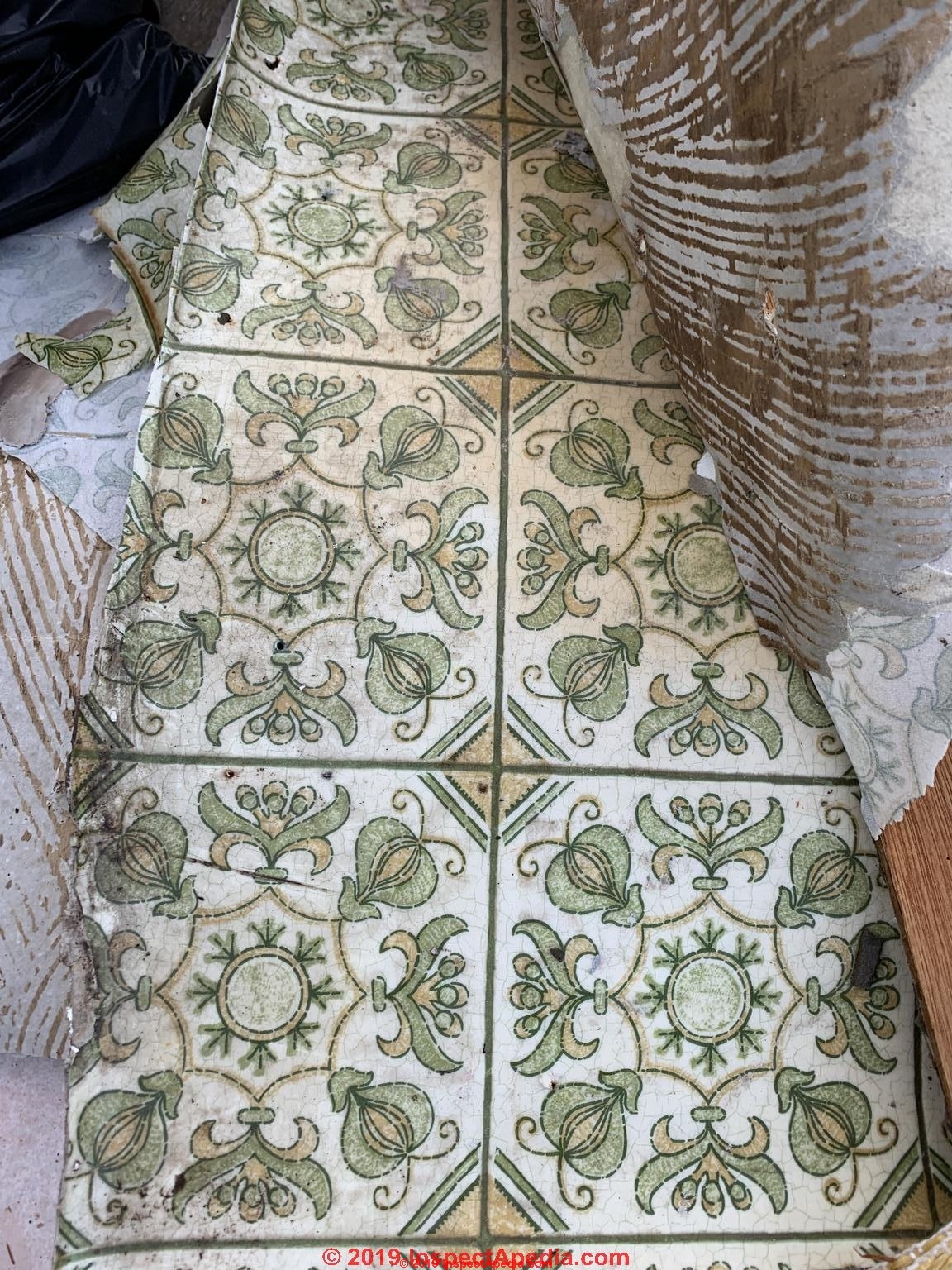 Can anyone help me identify this pattern of sheet flooring? It was removed in our house and we are working if it contains asbestos. 2019/07/15 bh Ben
Can anyone help me identify this pattern of sheet flooring? It was removed in our house and we are working if it contains asbestos. 2019/07/15 bh Ben
Moderator replied:Ben, that floor could contain asbestos but knowing at least its age and country / city of installation would help.
For a quick check and five easy questions that can help tell you if an unknown floor covering contains asbestos, try answering some of the easy questions at
DOES THIS FLOORING CONTAIN ASBESTOS?
How much harm if I've already scraped up the flooring?
Should i be worried about what i have tried scraping up already? What can i do to make sure house is clean of asbestos in the air. I dont want my 3 year old son to be around anything harmful. Feb 18, 2019 by Brock
Reply:Brock,
If you are facing a large cost or have other reasons to be concerned about asbestos contamination in the building it would not be costly to have a small sample of the floor tested. The advice at these 3 articles should be helpful.
- ASBESTOS FLOORING HAZARD REDUCTION
- ASBESTOS FLOORING IDENTIFICATION
- ASBESTOS FLOORING REMOVAL GUIDE
- ASBESTOS REMOVAL, WETTING GUIDELINES
Holes were drilled into asbestos vinyl flooring
A contractor drilled two .5 or .75 in holes in asbestos vinyl sheet flooring in a small half bath (20% according to lab). What is the likely extent of the risk/exposure and how long? Thanks! 2019-12-23 by James MatthewsReply:
Please see your question and our detailed reply now found at ASBESTOS FLOORING DAMAGE HAZARDS https://inspectapedia.com/hazmat/Asbestos-Floor-Damage-Hazard.php
and don't hesitate to ask follow-up questions as needed.
Please also use the add image button to post a photo of the drilled holes in the flooring in your home and I can comment further.
1960s house with cream-colored vinyl sheet flooring (a pebbly pattern) that tested positive for asbestos
I have a 1960s house with cream-colored vinyl sheet flooring (a pebbly pattern) that tested positive for asbestos (20%).
The asbestos inspection company that did the testing said that the flooring was in good shape, posed no immediate danger, and could be left as-is, but should be remediated if it was going to be disturbed or if renovations were going to take place.
That was about 2 years ago. I have read in many places that it is the backing on this flooring that contains asbestos, but I just wanted to confirm that he vinyl over-layer in such flooring generally is free from asbestos. The vinyl over-layer is essentially in perfect condition. Thanks. 2019-11-19 by Matthew Woodbury
Reply:
Yes it's usually the backer and sometimes and intermediate layer as well the top clear protective layers not likely to be in this pesos material. U-verse you got was correct that is it generally safest read the flooring in place and to cover it with new material
How do I know if flooring contains asbestos?
Can you tell if this linoleum/vinyl floor contains asbestos? I don't know the year it's from but guessing it's not 30-40 years old. 2019-11-04 by Lisa
Reply:
Lisa, with no information about the floor, building, country, city, I can't say with confidence that your floor does or doesn't contain asbestos.
But there is some easy-to-use help at making a reasonable guess over at DOES THIS FLOORING CONTAIN ASBESTOS? https://inspectapedia.com/hazmat/DIY-Asbestos-Floor-Test.php
Question: is this sheet flooring from a 1928 home asbestos?
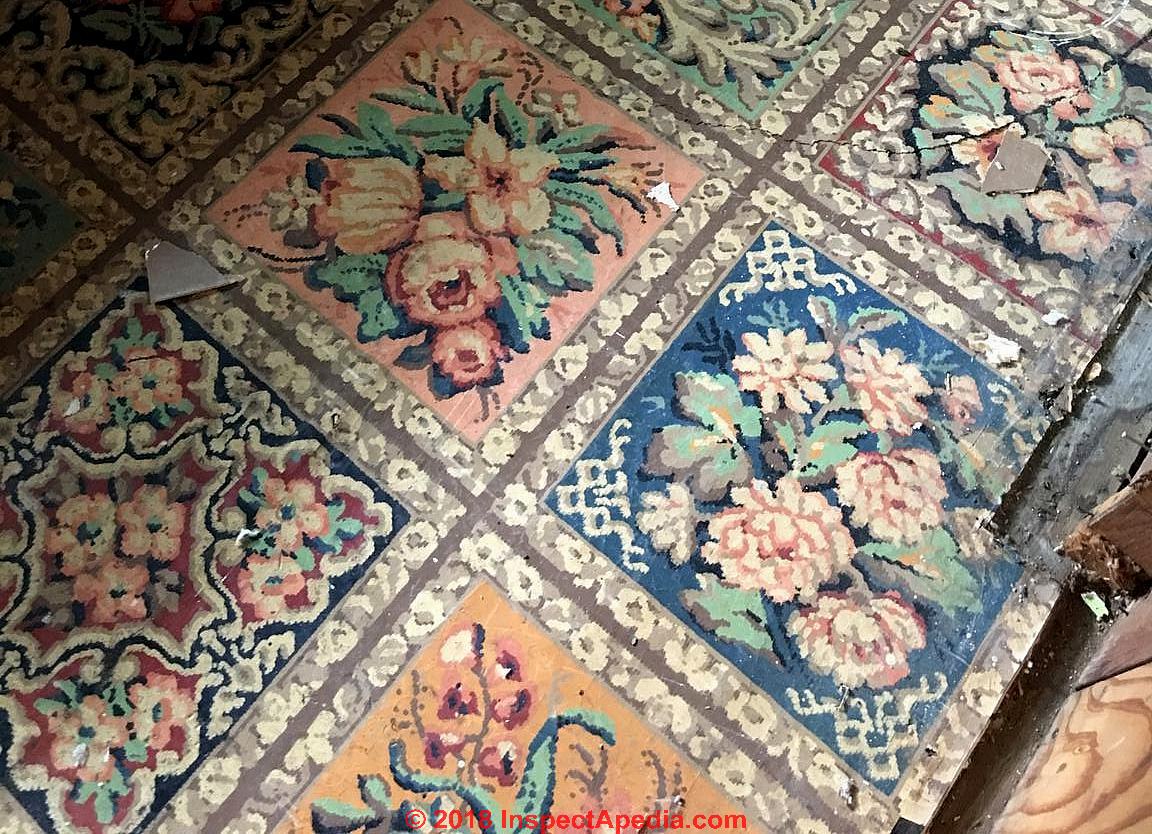 2018/06/01 Ashley said:
2018/06/01 Ashley said:
My house was built in 1928, I have no idea when this was laid... should I presume asbestos? It is sheet flooring.
This Q&A appeared originally at RESILIENT SHEET FLOORING ID GUIDE
Reply: linoleum rug - check for asphalt-impregnated paper or felt backer
Ashley,
While I cannot state with certainty the age or materials in your photo, from what I can see it looks as if you have on that floor an exceptionally lovely linoleum "rug", perhaps from the 1940's.
Take a look at the edges and back of the material.
If you see a canvas fabric-like backer it's a traditional jute-backed linoleum sheet flooring that is not likely to contain asbestos.
If you see a red rubber backer, ditto, with a few exceptions.
If you see a black asphalt-impregnated paper that looks like roofing felt or "tar paper" then that material might contain asbestos.
In any case if the linoleum rug is not glued down and can be removed by rolling it up and carrying it out, you can most likely remove it with little or no demolition. Avoid creating dust by chopping, grinding, sawing.
Attach photos of the back and edges if you can, when you remove the floor.
Damp wipe the remaining dust and debris from the original floor below. Show me what that looks like too.
More examples of this type of flooring are at
- ARMSTRONG SHEET FLOORING 1940 - 1980
- ARMSTRONG BRADFORD BRICK SHEET
- ARMSTRONG RUBBER BACKED RUG PATTERNS
- CONGOLEUM NAIRN SHEET FLOORING 1960 - 1980
- LINOLEUM & SHEET FLOORING for more photos of linoleum rugs and rug patterns.
Question: 1960's Sheet Flooring Asbestos: the manufacturer said if it wasn't black mastic, we are probably fine
(July 8, 2015) Ros said:
Hi. we recently purchased a home built in about 1965. It had multiple layers of flooring. We removed top layer of old hardwood, then a layer of cushion floor and layer of plywood and beneath that were tiles I am fairly certain are asbestos.
Tiles were intact so we left it and covered with plywood again as we plan to tile. Then I got to worrying whether the vinyl contained asbestos too. It came up generally intact but some pieces ripped and a bit of the backing remained behind.
I scrapped it up after wetting down with water. The adhesive was a light colour.
The vinyl was imprinted with Domco Series 46. I called the manufacturer and they can't tell me if it has asbestos or not. I would guess it was installed in the early 80's given the age of cabinets which sat on top of the vinyl. Any idea about this product?
The manufacturer said if it wasn't black mastic, we are probably fine. however, my internet search yields articles where this is a full on biohazard to don't worry about it, IF there is asbestos, the exposure is minimal. (unlike my grade school which allowed us to freely handle asbestos rocks in the classroom).
Anyways, I may try and get this tested but since it is already up, there's not much to be done about it, I am more curious to know in case this stuff is also in other parts of the house which we have yet to renovate...like bathrooms.
Reply:Ros
I don't know what has happened to Domcor flooring but their website, as of the moment, is DOA
I'd appreciate any contact information you have for the company, by post here or by email found at our page bottom CONTACT link. Use that email also to send me some photos of your flooring for further identification research.
In my OPINION if a company won't give a yes or now answer to asbestos in their products then something has made them nervous. Or put another way if I knew that my flooring never contained asbestos I'd be a dope not to say so.
ADVICE: For buildings with floor tiles or sheet flooring that can be assumed to have been installed in North America before 1986 it would be prudent to treat the flooring as "PACM" or "Presumed Asbestos Containing Material".
That does not mean we should panic nor undertake an expensive and dangerous asbestos removal project.
Asbestos is safe and legal to remain in homes or public buildings as long as the asbestos materials are in good condition and the asbestos can not be released into the air.
Generally the safest approach is to leave such flooring alone and to cover it over with a coating or with another layer of flooring.
Watch out: that the mastic used to adhere old sheet flooring may also contain asbestos. After trying various solvents on a black mastic years ago I discovered that it was water soluble and came up easily once I let it sit wet for a few hours. Try that.
J.W. Indeed I've found other similar flooring patterns to those in your photo that by date, records, tests, were confirmed as having asbestos in the vinyl backing; it would be prudent to treat the material as presumed-asbestos-containing material.
Don't panic; non-friable materials like this can usually be handled with a minimum of dust and debris - provided the floor was not glued down.
The flooring shown at above left, installed in the 1980's did not contain asbestos.
Details are
at SHEET & TILE FLOORING ASBESTOS ID-BRICK PATTERN ID
The flooring shown at above right in a white brick pattern (these are tiles not sheet flooring) contained asbestos. Sheet flooring in the same pattern also contained asbestos.
Reader Question: does this sheet flooring from a 1975 house contain asbestos?
I am hopeful you can help me determine if this sheet flooring found in a house built in 1975 might have asbestos.
I didn't see any patterns like it in your images in the asbestos area. I wondered if maybe you would recognize the pattern and be able to help me. - Anonymous, by private email, 2016/05/31
Reply:I don't know this exact pattern but some 70's sheet flooring very similar to it has tested and shown an asbestos content in the backer.
If you can remove it without making a dusty mess, intact, then the risks are probably low; if you need to do more aggressive demolition it's worth the $50. to have a confirming test - or to be safe just treat it as presumed to contain asbestos.
We discuss how to identify asbestos-containing sheet flooring
at RESILIENT SHEET FLOORING ID GUIDE
At the end of any of our asbestos-related InspectApedia pages, at CONTINUE READING you will find a complete ARTICLE INDEX to ASBESTOS HAZARDS
See therein
ASBESTOS FLOORING HAZARD REDUCTION
and
ASBESTOS FLOORING REMOVAL GUIDE
IF you are faced with a requirement for demolition and if you are uncertain about the flooring's asbestos content and cannot identify it through our guides, then you have a sample tested.
Reader follow-up:
... thanks a lot for getting back to me and providing these details. I pulled the flooring out of a basement bathroom not even thinking about asbestos until I was done. I am planning on having it tested because this same flooring is in two other areas.
It mostly came up in large sheets, and did not seem dusty to me at all during the removal process. But, I am still concerned. I suspect the small amount that may have come from the removal is not significant and I should be ok, I hope.
Anyway, thanks for the lab list, if you have a specific lab you would suggest please let me know. Please post the photos on your site. I will let you know what the test results are as well.
Reply:Just be sure to use a certified lab, and do let me see the results, as they may help others.
 Question: 1978 Armstrong Celarian sheet flooring has asbestos? Armstrong Premium Excelon Vinyl Composition Tile, product number 52127?
Question: 1978 Armstrong Celarian sheet flooring has asbestos? Armstrong Premium Excelon Vinyl Composition Tile, product number 52127?
(Sept 1, 2014) From Faribault said:
We built our house in 1978, and put in Armstong Celarian inlaid sheet flooring.We are in the midst of a remodeling project. What is the likelihood that it has asbestos?
(Aug 5, 2015) Katie F. said:
We bought a house in 2012 from someone who had owned it for 20 years and laid tile flooring when renovating the basement.
We found two boxes of these tiles - they are Armstrong Premium Excelon Vinyl Composition Tile, product number 52127.
The box has a side panel warning indicating that these should not be sanded as there may be undetectable asbestos. I need to have work done in the basement because we have moisture issues - what is the risk if these tiles need to be removed for this work?
Do I need to hire an abatement firm
Other readers ask about asbestos content in various sheet flooring products
We have the San Roque pattern sheet vinyl. Did Armstrong use the same patterns at a later date for their sheet vinyl but without asbestos? We have already started to remove it and I am concerned. - Sue 10/24/2012
We have vinyl sheet flooring that was put in about mid 1984. Is this anything to worry about? When exactly was asbestos banned in the manufacture of sheet flooring? - Peter 11/6/2012
I have an old ranch home w/ sheet lino.x2 layers, over OSB board, over another type of flooring over old hardwood. From what I can see so far. The hardwood has blunt square ends, and is about 3-4" wide and appears to have paint on it. I know there is some rot in that area and would need replacing from reclaimed wood.
My question is what is the best way to remove all the lino and OSB and floor below that to get to the hardwood? I know it's going to be labor intensive but not sure how to go about it. - Tracey 2/13/2012
(Apr 29, 2015) Brent said:
I have a 1988 Hino school bus that i am converting to a house bus and am wondering if the vinyl floor has asbestos or not.
Does anyone have any ideas on that? The flooring is sheet vinyl lino and not tiles. Cheers
Reply: Basic Advice for Floor Tiles or Sheet Flooring that Might Contain Asbestos
For Matt, Faribault & Katie F and other readers:
Thank you for the question about possible asbestos in flooring.
I do not recognize the exact pattern of your flooring, though you may find a close match in the library of asbestos floor tiles and sheet flooring beginning at ASBESTOS FLOORING IDENTIFICATION
Because there are so many manufacturers and floor tile patterns, types, sizes, and colors over many decades just looking through catalogs organized by even color or pattern can be a daunting task.
Better is to narrow the question by forming a reasonable guess about the age of the floor tile or sheet flooring. We can at the very least narrow this down by knowing the age of the building and sometimes we can narrow the guess further if we know when a building was renovated, or by observing the type of tile adhesive or mastic used.
WIth that data we can choose among our floor tile or sheet flooring photo ID guides that are organized by year beginning at the link I give above.
PHOTOS: You are welcome to send me photos of floor tiles, and where loose tiles or packaging are available I'd want to see the back side of tile and all sides of packaging and labels.
Knowing the tile dimensions and thickness are also useful. Our email link is also found at the CONTACT link at the top or bottom of any InspectApedia.com page.
Basic advice:
For buildings with floor tiles or sheet flooring that can be assumed to have been installed in North America before 1986 it would be prudent to treat the flooring as "PACM" or "Presumed Asbestos Containing Material".
That does not mean we should panic nor undertake an expensive and dangerous asbestos removal project.
Asbestos is safe and legal to remain in homes or public buildings as long as the asbestos materials are in good condition and the asbestos can not be released into the air.
Generally the safest approach is to leave such flooring alone and to cover it over with a coating or with another layer of flooring.
Watch out: do not grind, cut, saw, chop or otherwise demolish flooring that may contain asbestos: you don't want to use methods that create a dusty mess.
On any of our asbestos-related InspectApedia pages, at CONTINUE READING you will find a complete ARTICLE INDEX for dealing with asbestos containing materials.
See in that
list ASBESTOS FLOORING HAZARD REDUCTION
andASBESTOS FLOORING REMOVAL GUIDE
IF however you are faced with a requirement for a dusty messy demolition and if you are uncertain about the flooring's asbestos content and cannot identify it through our guides, then you may want to have a sample tested.
In that case see ASBESTOS TESTING LAB LIST
We would much appreciate hearing any comments, critique, suggestions, or further questions that you may have after you've taken a look at the articles I've cited.
Angela W
Don't confuse asbestos hazards with asthma and allergies, nor with condensation.
Unless you are grinding, chopping, hacking your vinyl asbestos floor tiles, with them just sitting there the probability that you can measure a harmful level of asbestos release is nearly zero.
The moisture problem is a separate one to correct. Find and fix the moisture soruces, run a dehumidifier if necessary;
When the floor is dry you may want to seal it or cover it with something less horrible for allergy.asthma sufferers than carpeting.
Question: probability of asbestos in sheet flooring in a 1990 home?
(Oct 22, 2015) Dennis said:
The house I live in was supposedly built in1990. I started removing old flooring in the bathroom when upon an internet search on how to, I started seeing articles about asbestos in vinyl flooring. It is sheet vinyl with a paper type backing. At this point I'm treating it like it does. Do I have to worry?
Reply:Dennis we can't know by e-text precisely what material you're disturbuing, but certainly if it dates from 1990 in the U.S. that's past the date that one would expect to find new asbestos-containing floor coverings being installed.
Question: floor at my job looks hot but I'm told it's safe, I want to send a photo
(May 12, 2016) Anonymous said:
The floor at my job looks hot but they're telling me it's safe but it doesn't look safe to me I'm trying to send a picture but I'm
Reply:You can use the page top or bottom CONTACT link to send flooring photos for comment.
Other Questions about Asbestos in Sheet Flooring
Question: did asbestos flooring come in just tiles or also in roll or sheet flooring?
Can the asbestos flooring come in tiles only or does it come in a role? - P.H. 12/31/12
Reply:Asbestos-containing flooring was sold in both individual floor tiles and in rolls of sheet flooring. But just as with vinyl or plastic floor tiles, not all flooring contains asbestos.
LINOLEUM & Other Sheet Flooring includes examples of sheet flooring that often did not contain asbestos.
To treat floor coverings in asphalt-based floor tiles or sheet flooring, or vinyl (plastic)-based floor tiles or sheet flooring, it is reasonable to treat flooring sold in the year ranges described in the article above as PACM (Presumed Asbestos Containing Material).
Also the mastic or adhesive used to install flooring may also contain asbestos. Keep in mind also that very often it is not necessary nor even recommended to remove PACM floor coverings. But if conditions require that it be removed,
see ASBESTOS REMOVAL GUIDE, FLOORING.
Asbestos-containing sheet flooring in good condition in a residential environment is not a high risk of causing airborne asbestos hazards as the material is not friable. The safest as well as least-costly course of action is to leave such flooring in place, and to cover it over with other flooring material.
However if such flooring installed in North America before the early 1980's is in very poor condition or if it must be demolished as part of building renovations, it should be treated as presumed to contain asbestos and handled accordingly.
Flooring adhesives or mastics also may contain asbestos.
Identifying flooring in a 1912 Alaskan home
I just bought a 1912 house in Alaska. I immediatly pulled up the carpet to find old sheet linoleum in a brown marble pattern. It looks like it came in 6' rolls unless the sheets are 15' long.
When I pull up a sheet it does not appear to be adhered to the floor, however it looks like the linoleum may have been adhered to a layer of black hard rubber, or maybe thick asphalt?
I am trying to figure out how to submit photos but it definitely appears the linoleum was separate from the base layer as the seams do not match up.
We are concerned about asbestos being in any part of this layout before we remove. Thanks for input. Leslie 2017-03-09 by leslie
Reply:
Leslie
I'd like to see photos of the sheet flooring pattern and also to see it's underside - use the page top or bottom CONTACT link to send me some photos. (Sorry, for reader and site security protection, Comments Box doesn't yet permit photo posting).
I'm not sure what is under the flooring you are describing; often a black asphalt-based mastic was used to adhere sheet flooring to a wood subfloor; that could have deteriorated or dried out to release the flooring.Beware that some of those mastics contained asbestos: not a high risk as long as you're not grinding or chopping to make dust.
Search InspectApedia.com for MASTIC, CUTBACK ADHESIVE, FLASHING CEMENT ASBESTOS to read about that material.
Also see ASBESTOS FLOORING REMOVAL GUIDE
What about asbestos-containing flooring in a house in France?
Hi we are about to buy a little house in France, the compulsory survey says that the surveyor thinks there maybe asbestos in the vynyl flooring of the bedrooms, he says it would be ok to leave he floor but has to tell us n case we ever wanted to remove the floor, the house was built pre 50's.
would you reccomend us to go ahead with the purchase and if we do would it be possible to carry out work such as putting fitted wardrobes in these rooms which may entail drilling to attach them to the floor, would be very grateful for your advice, and thank you barbara 2017-02-27 by barbara
Reply: best practice to leave vinyl-asbestos flooring alone
Barbara
Considering that in 100% of the cases in which I've been to a property about which there was a question asked by mail or phone ,I've seen substantial conditions that were not mentioned nor obvious to the buyer/owner, I can't bet your money nor safety on a simple e-text.
That apology said, it's not only reasonable but it's the recommended best practice to leave vinyl-asbestos flooring alone - best option is covering it over. To be avoided is grinding, chopping, sawing, demolition that makes a dusty mess. An alternative that I've used is application of a hard sealant or even an epoxy paint.
Drilling disturbs a trivial amount of material, say less than 4" for four large holes. Wetting and wiping up to control dust would be in order and should leave the amount of airborne dust from drilling below the limits of detection.
Flooring sold in the year 2000 not likely to be an asbestos-containing product
Have Congoleum floor tiles in kitchen that I bought and installed in 2000 I do have extra tiles and box with manufacture codes on it. Is there a way to check on asbestos content without testing? 2016-09-13 by Bob
Reply:
Bob
It would be extremely odd for flooring made and sold 14 - 16 years after the last asbestos containing flooring was manufactured to have been sold and installed in the year 2000.
Asbestos om DOMCO Flooring by Tarkett?
My house was built around 1970 and has two layers of a vinyl flooring.
The bottom layer has the letters DOMCO series stamped on the backing and I would like to know if it could contain asbestos and wonder if that's why they left it in place and added another floor over top? 2016-08-23 by Sandy
Mod reply:
I don't know how old your specific floor is, but as our illustration shows, Domco is a contemporary flooring brand made well asfter the early 1980's that marks the end of common production of asbestos-containing flooring in North America as well as most of Europe.
Domco is a vinyl sheet flooring produced by Tarkett Flooring, an old-established brand sold world wide.
Tarlett Flooring, Website: http://www.tarkettna.com/ The company does a remarkable job of making it almost impossible to obtain a corporate headquarters or mailing or street address, preferring to refer the public to its retail outlets or press contacts.
It's prudent to treat 1970's vinyl sheet flooring as presumed to contain asbestos.
ADVICE: For buildings with floor tiles or sheet flooring that can be assumed to have been installed in North America before 1986 it would be prudent to treat the flooring as "PACM" or "Presumed Asbestos Containing Material".
That does not mean we should panic nor undertake an expensive and dangerous asbestos removal project.
Asbestos is safe and legal to remain in homes or public buildings as long as the asbestos materials are in good condition and the asbestos can not be released into the air.
Generally the safest approach is to leave such flooring alone and to cover it over with a coating or with another layer of flooring.
On any of our asbestos-related InspectApedia pages, at CONTINUE READING you will find a complete ARTICLE INDEX to ASBESTOS HAZARDS
See also therein
ASBESTOS FLOORING HAZARD REDUCTION
and
ASBESTOS FLOORING REMOVAL GUIDE
IF you are faced with a requirement for demolition and if you are uncertain about the flooring's asbestos content and cannot identify it through our guides, then you have a sample tested.
Would not expect asbestos to be present in flooring made in 1994
I'm removing some sheet vinyl flooring from a house built in 1994, that should be asbestos free by date, but the medium gray backing (like thick paper)clearly has many tiny fibers protruding from the edges when it is torn. Is this more likely to be fiberglass that I am seeing, or could it be asbestos? The pattern is very similar to the image above directly under the red "Watch out" text, but the pattern is all gray, with no blue or red. 2016-02-04 by Bob
Reply:
Bob:
Yes, I would not expect asbestos to be present in flooring made in 1994.
Thank you to our readers for their generous comments
On 2019-12-26 by James Matthews
Thanks so much for your thoughtful, detailed response. I greatly appreciate it. It was like a Christmas gift, and I thank you.
...
Continue reading at RESILIENT SHEET FLOORING ID GUIDE - topic home, or select a topic from the closely-related articles below, or see the complete ARTICLE INDEX.
Or see these
Recommended Articles
- ASBESTOS FLOORING HAZARD REDUCTION
- ASBESTOS FLOOR IDENTIFICATION - home
- DOES THIS FLOOR CONTAIN ASBESTOS? - 5 easy questions to tell if your FLOOR probably contains asbestos -
- DOES THIS MATERIAL CONTAIN ASBESTOS? - 5 easy questions to tell if a BUILDING MATERIAL probably contains asbestos -
- ASBESTOS FLOORING HAZARD REDUCTION
- ASBESTOS FLOORING IDENTIFICATION
- ASBESTOS FLOORING REMOVAL GUIDE
- ASBESTOS REMOVAL, WETTING GUIDELINES
- ASBESTOS TESTING LAB LIST
- IDENTIFY SHEET FLOORING TYPE
- POURED-IN-PLACE FLOORING, RESILIENT
- RESILIENT SHEET FLOORING ID GUIDE - home
- SHEET FLOORING INSPECT / TEST
- SHEET FLOORING NON-ASBESTOS EXAMPLES
- SHEET FLOORING POSSIBLE ASBESTOS - 1960-1987
- SHEET FLOORING INSPECT / TEST
- SHEET FLOORING TYPE IDENTIFICATION
- WHITE SHIELD® BACKING ASBESTOS in FLOORING
Suggested citation for this web page
ASBESTOS SHEET FLOORING ID FAQs at InspectApedia.com - online encyclopedia of building & environmental inspection, testing, diagnosis, repair, & problem prevention advice.
Or see this
INDEX to RELATED ARTICLES: ARTICLE INDEX to ASBESTOS HAZARDS
Or use the SEARCH BOX found below to Ask a Question or Search InspectApedia
Ask a Question or Search InspectApedia
Try the search box just below, or if you prefer, post a question or comment in the Comments box below and we will respond promptly.
Search the InspectApedia website
Note: appearance of your Comment below may be delayed: if your comment contains an image, photograph, web link, or text that looks to the software as if it might be a web link, your posting will appear after it has been approved by a moderator. Apologies for the delay.
Only one image can be added per comment but you can post as many comments, and therefore images, as you like.
You will not receive a notification when a response to your question has been posted.
Please bookmark this page to make it easy for you to check back for our response.
IF above you see "Comment Form is loading comments..." then COMMENT BOX - countable.ca / bawkbox.com IS NOT WORKING.
In any case you are welcome to send an email directly to us at InspectApedia.com at editor@inspectApedia.com
We'll reply to you directly. Please help us help you by noting, in your email, the URL of the InspectApedia page where you wanted to comment.
Citations & References
In addition to any citations in the article above, a full list is available on request.
- In addition to citations & references found in this article, see the research citations given at the end of the related articles found at our suggested
CONTINUE READING or RECOMMENDED ARTICLES.
- Carson, Dunlop & Associates Ltd., 120 Carlton Street Suite 407, Toronto ON M5A 4K2. Tel: (416) 964-9415 1-800-268-7070 Email: info@carsondunlop.com. Alan Carson is a past president of ASHI, the American Society of Home Inspectors.
Thanks to Alan Carson and Bob Dunlop, for permission for InspectAPedia to use text excerpts from The HOME REFERENCE BOOK - the Encyclopedia of Homes and to use illustrations from The ILLUSTRATED HOME .
Carson Dunlop Associates provides extensive home inspection education and report writing material. In gratitude we provide links to tsome Carson Dunlop Associates products and services.



